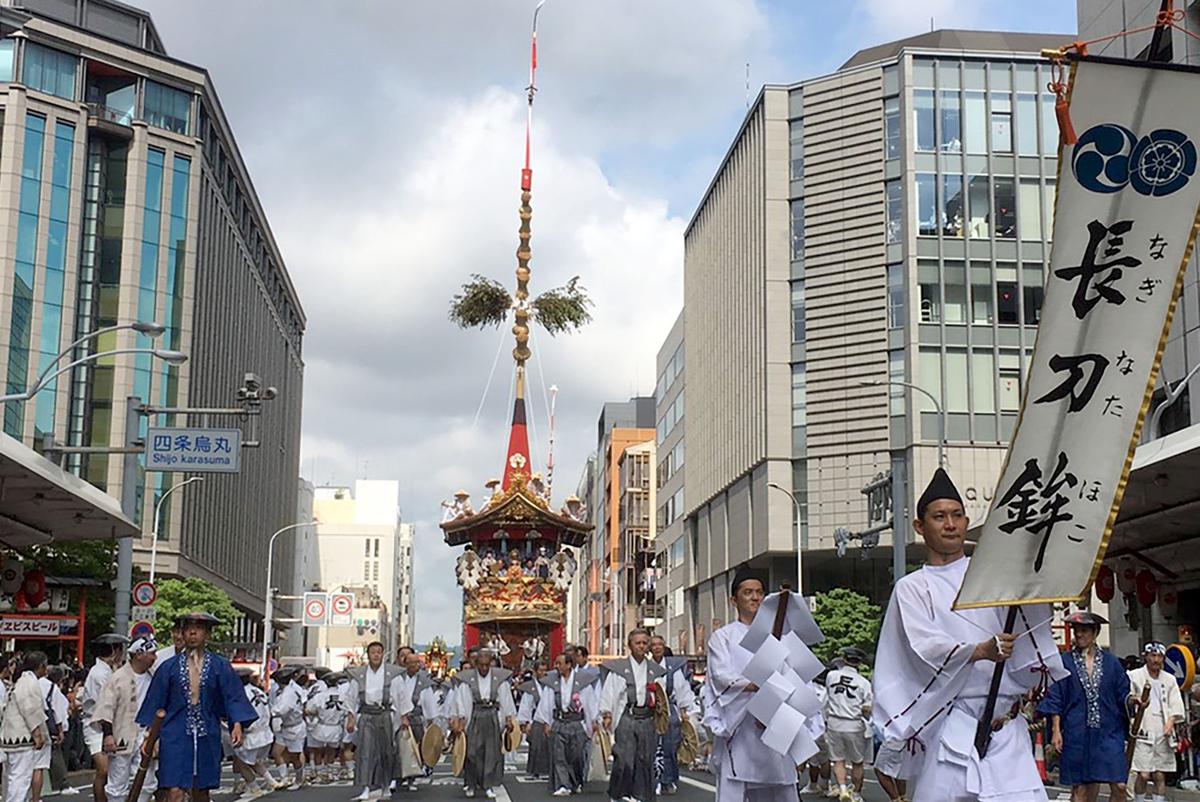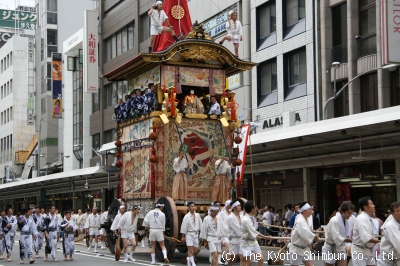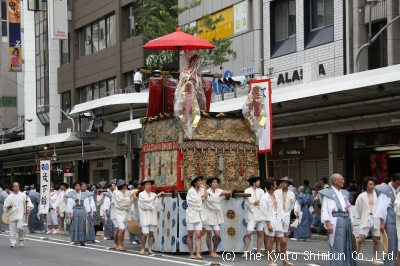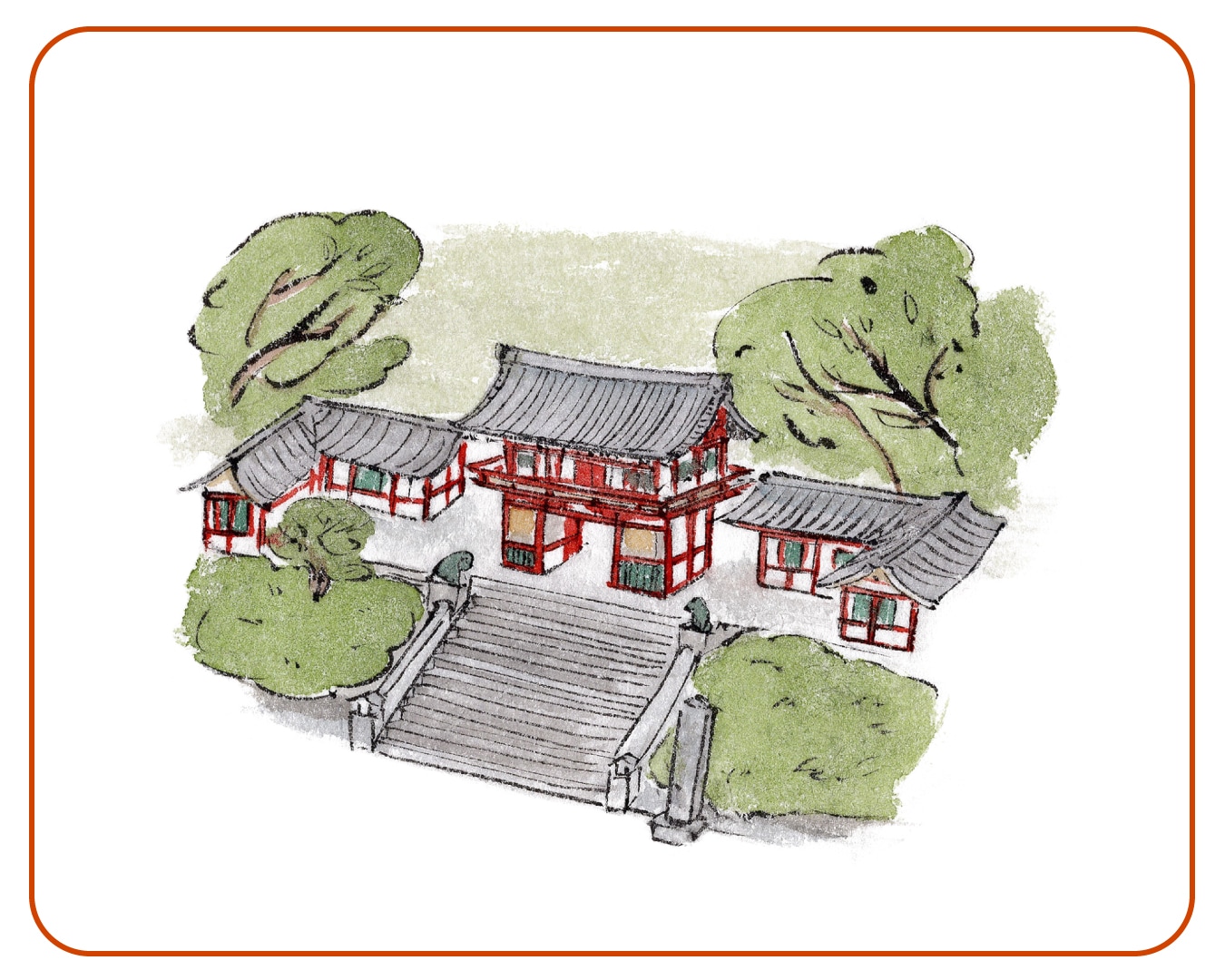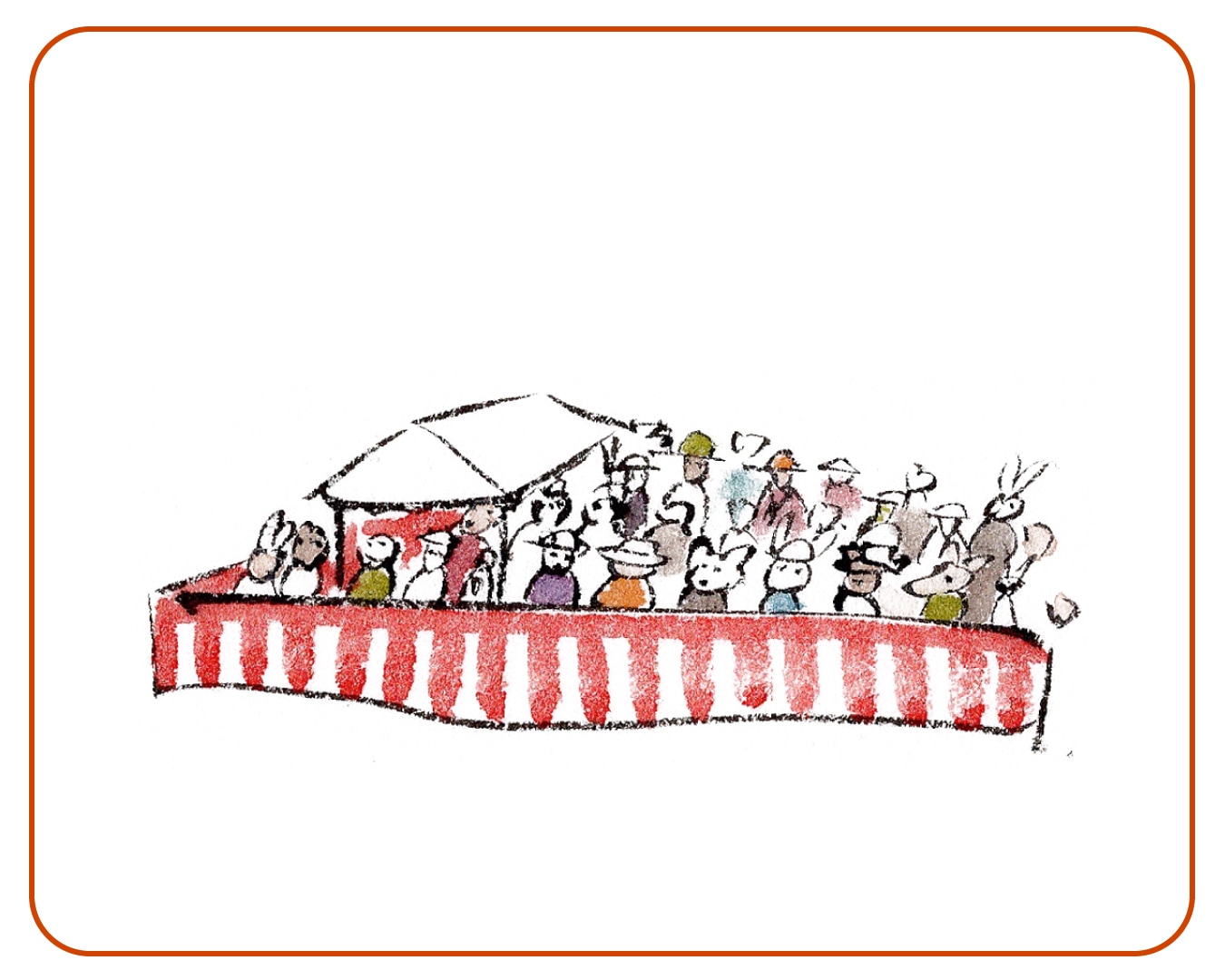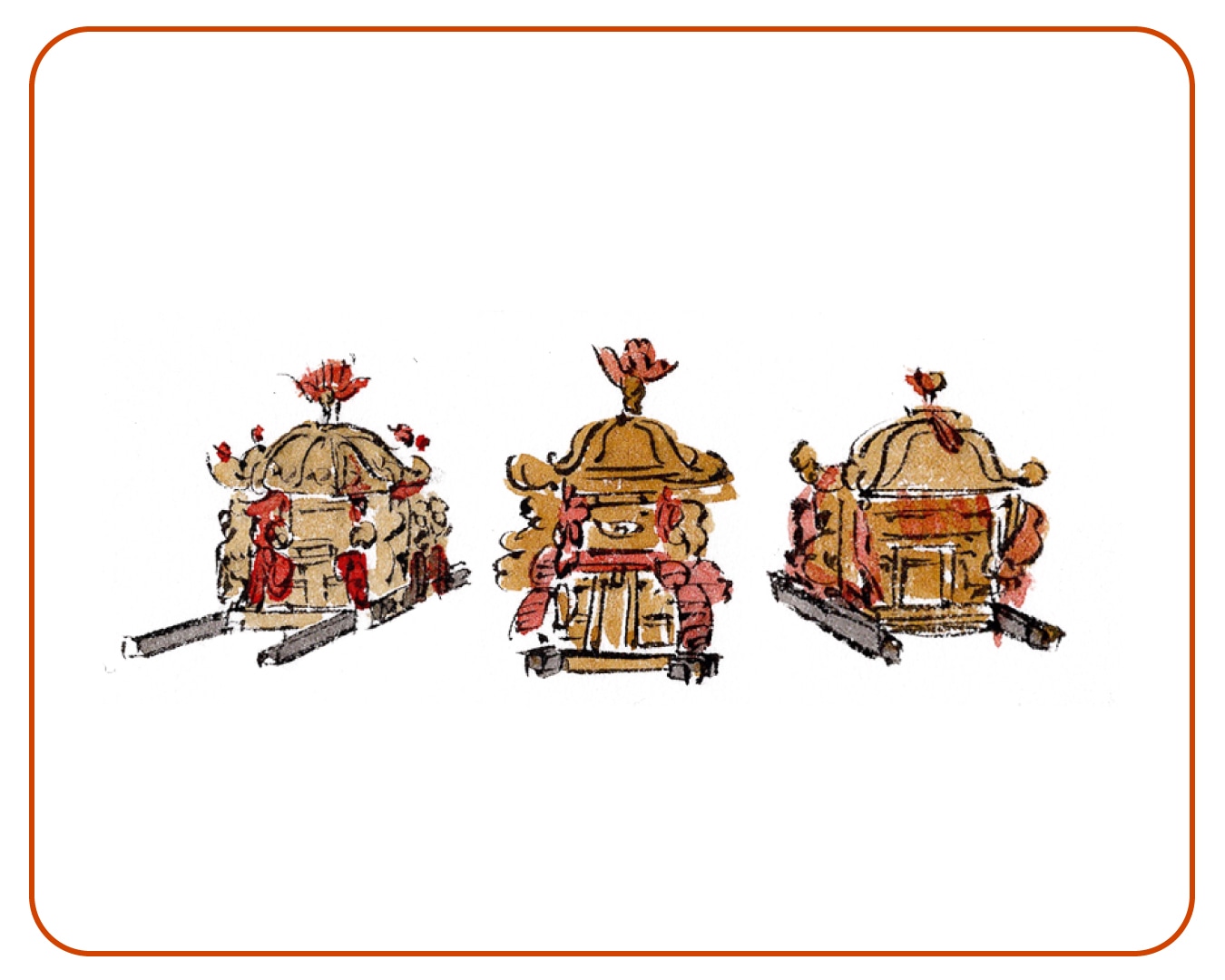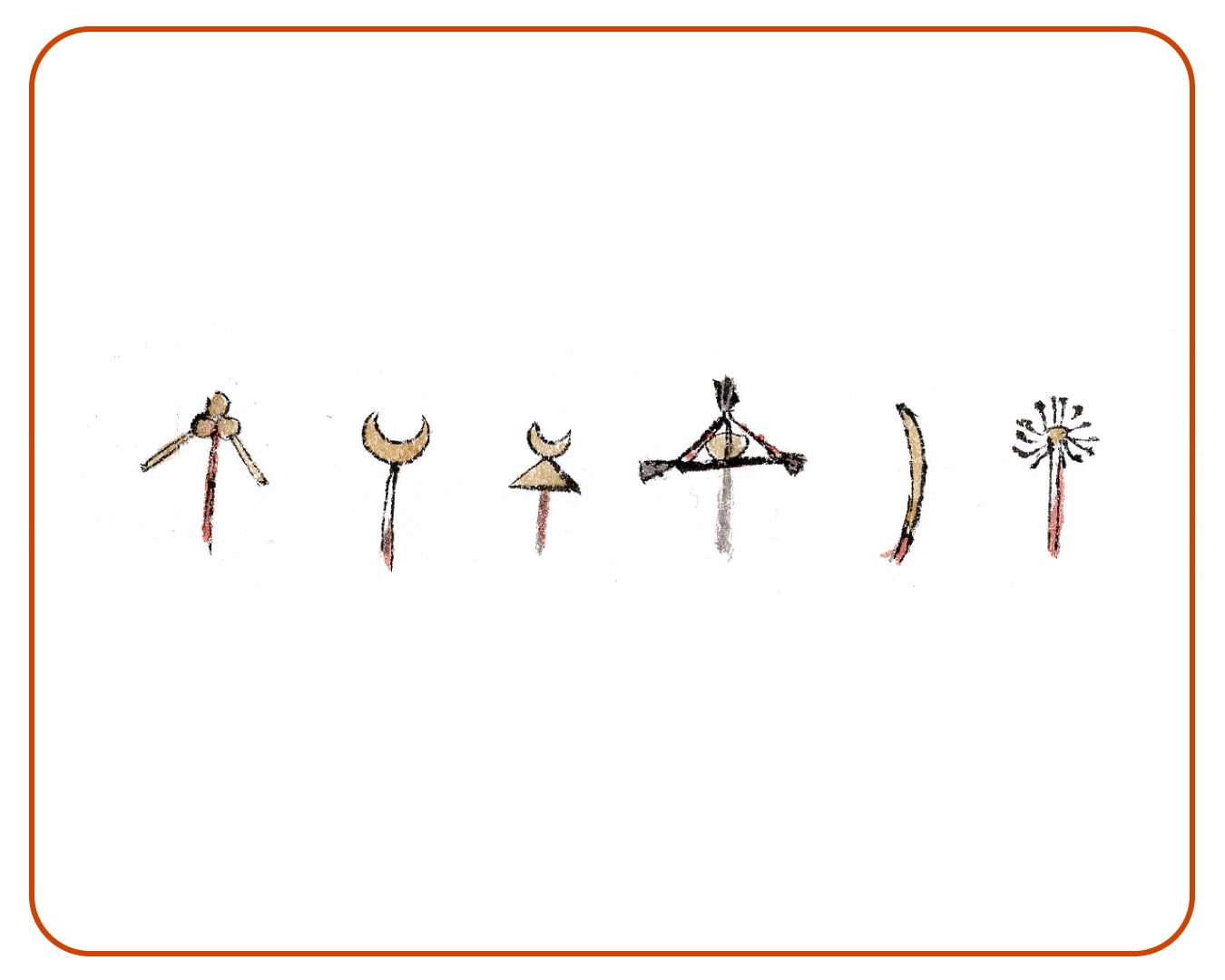前祭 祇園祭デジタル絵地図2025
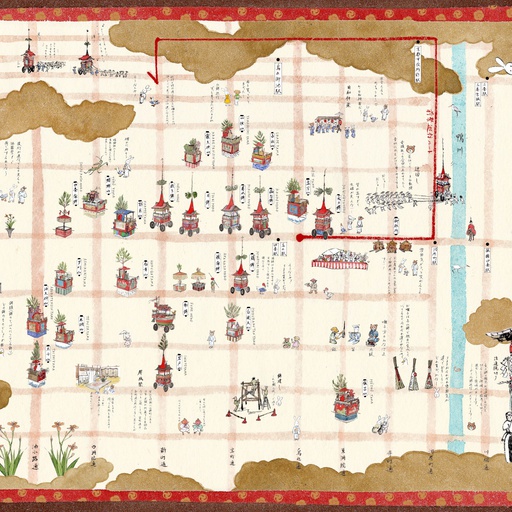
このマップは京都新聞社とStrolyでコラボレーションを行い、祇園祭を現地でも、おうちでも楽しめる祇園祭マップを作成しました。 マップ部分は完全手描きでの描き下ろし作品となり、「鳥獣戯画」を彷彿とさせる、個性豊かなキャラクターたちが祇園祭を楽しむ様子をご覧いただけます。 スポット情報では、京都新聞社提供の祇園祭に登場する各山鉾の情報はもちろん、祇園祭に関連する主要な神事や行事についてもご紹介。7月1日から31日まで開催される祇園祭を、余すことなくお届けします。
すべてのスポット情報
34件のスポット
 前祭 鉾一覧
前祭 鉾一覧
長刀鉾(なぎなたほこ)
![]() 前祭 鉾一覧
前祭 鉾一覧
巡行の先頭、稚児ちごが乗る唯一の鉾 巡行時の様子 「くじとらず」の名があるように、山鉾巡行の先頭を受け持つ鉾。命名は、鉾のてっぺんを飾った三条小鍛冶宗近むねちか作の大長刀おおなぎなたによる。宗近が娘の病気平癒を祈願して八坂やさか神社に奉納したが、鎌倉期にある武人が愛用。しかし何かと不思議が起こり、返納したという。大永2(1522)年、疫病がはやり、神託で長刀鉾町で飾ったところ、疫病は退散した。創建は、嘉吉元年(1441)説がある。真木しんぎは全長20メートル。現在、稚児ちごが乗る唯一の鉾である。 INFO 【場所】四条通東洞院西入ル 【日程】 鉾建:7/9 7:00〜曳初ひきぞめ:7/12 15:30〜宵山:7/14〜巡行:7/17 9:00〜 【Webサイト】 公益財団法人 長刀鉾保存会 ← 2番目→ 占出山 京都新聞 動画ライブラリ 祇園祭の過去映像をご紹介。 他の祇園祭の過去映像はこちら(別タグで開きます。) 全方位で体感 ― 360度パノラマ映像 過去に撮影された山鉾の様子を360度パノラマ映像でご覧いただけます 別タグで開く 祇園祭入門 祇園祭とは 日本の三大祭の一つに挙げられる祇園祭は、毎年7月1日から31日までの1カ月間、京都市内の中心部や八坂神社(東山区)で行われる。クライマックスの山鉾巡行や神幸祭をはじめ、多彩な祭事が繰り広げられる。 祇園祭の由来と歴史 平安時代前期の869(貞観11)年、京で疫病が流行した際、広大な庭園だった神泉苑(中京区)に、当時の国の数にちなんで66本の鉾を立て、八坂神社の神輿を迎えて災厄が取り除かれるよう祈ったことが始まりとされる。 応仁の乱(1467~77年)で山鉾巡行は途絶えたが、1500(明応9)年に町衆の手で再興された。以後、中国やペルシャ、ベルギーなどからもたらされたタペストリーなどを各山鉾に飾るようになった。これらの懸装品の豪華さゆえに、山鉾は「動く美術館」とも呼ばれる。江戸時代にも火災に見舞われたが、町衆の力によって祭りの伝統は現代まで守られている。2009年にはユネスコ無形文化遺産に登録された。 山鉾巡行は本来、神輿渡御に伴う「露払い」の位置づけで、神幸祭に先立つ「前祭(さきまつり)」と還幸祭の「後祭(あとまつり)」がある。高度成長期以来、交通渋滞や観光促進を理由に、前祭と後祭の合同巡行が続いていたが、祭り本来の形を取り戻そうと分離が決定。2014年、約半世紀ぶりに後祭の山鉾巡行が復活した。 注連縄切りの大役を堂々と果たす長刀鉾稚児 祇園祭のスケジュール 毎年、7月1日の「吉符入り」で幕を開け、2日には山鉾巡行の順番を決める「くじ取り式」が京都市役所で行われる。10日頃から前祭の鉾建てが始まり、12日頃には鉾の「曳初(ひきぞ)め」がある。14日の宵々々山、15日の宵々山、16日の宵山を経て、17日は、前祭の23の山鉾が祇園囃子(ばやし)にのって京都のメーンストリートを巡行。 前祭山鉾巡行の翌日から、後祭に向けて鉾建てが始まる。21~23日は宵山期間で、24日は後祭の山鉾巡行。あわせて花笠巡行も繰り広げられる。夕方には、神輿が御旅所から神社に戻る還幸祭がある。 石段下を埋め尽くすように集まった担ぎ手たちが気勢を上げて3基のみこしを運ぶ。 祇園祭の見どころ 前祭・山鉾巡行まで 12日頃の「曳初(ひきぞ)め」は、女性を含む一般市民も参加できることが多い。16日の宵山までは、各山鉾町ではちょうちんの明かりに照らされた山や鉾が楽しめる。各山鉾では、病気除けとされるちまきや、学問成就や立身出世などのお守り(護符)を手に入れることもできる。 前祭・山鉾巡行当日 午前9時、計23基の山鉾が四条烏丸付近を出発。四条通を東へ向かった後、河原町通を北上し、御池通を西進する。四条麩屋町での長刀鉾稚児による「注連縄(しめなわ)切り」や、山鉾が各交差点で方向を変える「辻(つじ)回し」などが見どころ。 後祭・山鉾巡行まで 前祭の山鉾巡行の翌日から、大船鉾の鉾建てが始まる。宵山では露店の出店が規制され、本来の祭り情緒が楽しめそう。 後祭・山鉾巡行当日 午前9時半に計11基が烏丸御池を出発。前祭とは逆向きのコースを進む。復活した大船鉾や、前祭とは逆向きの辻回しなどに注目が集まる。後祭列が復活するまで長らく代わりとなっていた花傘巡行の行列も、後祭列を追うよう御池通や河原町通を進む。 車輪をきしませながら「辻回し」を披露する長刀鉾 (c) The Kyoto Shimbun Co.,Ltd. All rights reserved. ▲TOP
函谷鉾(かんこほこ)
![]() 前祭 鉾一覧
前祭 鉾一覧

中国古代、孟嘗君もうしょうくんの故事に基づく 巡行時の様子 中国古代史話、孟嘗君もうしょうくんの故事に基づく。戦国時代、斉せいの孟嘗君は秦しんの昭王しょうおうに招かれ、宰相さいしょうに重用された。しかし讒言ざんげんによって咸陽かんようを脱出して、函谷関かんこくかんまで逃げたが、関の門は鶏が鳴かねば開かない。配下が鶏の鳴き声をまねたところ、あたりの鶏が和して刻をつくったので見事通り抜けたという。真木しんぎは22メートル。鉾頭に、三角形の白麻を張り、先頭に三日月が上向きにとりつけられる。 INFO 【場所】四条通烏丸西入ル 【日程】 鉾建:7/10 7:00〜曳初ひきぞめ:7/12 14:00〜宵山:7/14〜巡行:7/17 9:00〜 【Webサイト】 公益財団法人 函谷鉾保存会 ←4番目 山伏山 6番目→ 油天神山 京都新聞 動画ライブラリ 祇園祭の過去映像をご紹介。 他の祇園祭の過去映像はこちら(別タグで開きます。) 全方位で体感 ― 360度パノラマ映像 過去に撮影された山鉾の様子を360度パノラマ映像でご覧いただけます 別タグで開く 祇園祭入門 祇園祭とは 日本の三大祭の一つに挙げられる祇園祭は、毎年7月1日から31日までの1カ月間、京都市内の中心部や八坂神社(東山区)で行われる。クライマックスの山鉾巡行や神幸祭をはじめ、多彩な祭事が繰り広げられる。 祇園祭の由来と歴史 平安時代前期の869(貞観11)年、京で疫病が流行した際、広大な庭園だった神泉苑(中京区)に、当時の国の数にちなんで66本の鉾を立て、八坂神社の神輿を迎えて災厄が取り除かれるよう祈ったことが始まりとされる。 応仁の乱(1467~77年)で山鉾巡行は途絶えたが、1500(明応9)年に町衆の手で再興された。以後、中国やペルシャ、ベルギーなどからもたらされたタペストリーなどを各山鉾に飾るようになった。これらの懸装品の豪華さゆえに、山鉾は「動く美術館」とも呼ばれる。江戸時代にも火災に見舞われたが、町衆の力によって祭りの伝統は現代まで守られている。2009年にはユネスコ無形文化遺産に登録された。 山鉾巡行は本来、神輿渡御に伴う「露払い」の位置づけで、神幸祭に先立つ「前祭(さきまつり)」と還幸祭の「後祭(あとまつり)」がある。高度成長期以来、交通渋滞や観光促進を理由に、前祭と後祭の合同巡行が続いていたが、祭り本来の形を取り戻そうと分離が決定。2014年、約半世紀ぶりに後祭の山鉾巡行が復活した。 注連縄切りの大役を堂々と果たす長刀鉾稚児 祇園祭のスケジュール 毎年、7月1日の「吉符入り」で幕を開け、2日には山鉾巡行の順番を決める「くじ取り式」が京都市役所で行われる。10日頃から前祭の鉾建てが始まり、12日頃には鉾の「曳初(ひきぞ)め」がある。14日の宵々々山、15日の宵々山、16日の宵山を経て、17日は、前祭の23の山鉾が祇園囃子(ばやし)にのって京都のメーンストリートを巡行。 前祭山鉾巡行の翌日から、後祭に向けて鉾建てが始まる。21~23日は宵山期間で、24日は後祭の山鉾巡行。あわせて花笠巡行も繰り広げられる。夕方には、神輿が御旅所から神社に戻る還幸祭がある。 石段下を埋め尽くすように集まった担ぎ手たちが気勢を上げて3基のみこしを運ぶ。 祇園祭の見どころ 前祭・山鉾巡行まで 12日頃の「曳初(ひきぞ)め」は、女性を含む一般市民も参加できることが多い。16日の宵山までは、各山鉾町ではちょうちんの明かりに照らされた山や鉾が楽しめる。各山鉾では、病気除けとされるちまきや、学問成就や立身出世などのお守り(護符)を手に入れることもできる。 前祭・山鉾巡行当日 午前9時、計23基の山鉾が四条烏丸付近を出発。四条通を東へ向かった後、河原町通を北上し、御池通を西進する。四条麩屋町での長刀鉾稚児による「注連縄(しめなわ)切り」や、山鉾が各交差点で方向を変える「辻(つじ)回し」などが見どころ。 後祭・山鉾巡行まで 前祭の山鉾巡行の翌日から、大船鉾の鉾建てが始まる。宵山では露店の出店が規制され、本来の祭り情緒が楽しめそう。 後祭・山鉾巡行当日 午前9時半に計11基が烏丸御池を出発。前祭とは逆向きのコースを進む。復活した大船鉾や、前祭とは逆向きの辻回しなどに注目が集まる。後祭列が復活するまで長らく代わりとなっていた花傘巡行の行列も、後祭列を追うよう御池通や河原町通を進む。 車輪をきしませながら「辻回し」を披露する長刀鉾 (c) The Kyoto Shimbun Co.,Ltd. All rights reserved. ▲TOP
鶏鉾(にわとりほこ)
![]() 前祭 鉾一覧
前祭 鉾一覧

鶏×太鼓は太平治安の象徴 巡行時の様子 中国古代の伝説「諫鼓かんこ」、天の岩戸の永世の長鳴鳥ながなきとりの故事にちなむとも。「諫鼓かんこ」は、暦を制定した伝説の聖天子・尭帝ぎょうていが、宮廷の外に太鼓をすえ、政治に不満があればたたかせ、木を立てて、訴えを書かした。世は治まり、太鼓は苔を生じて鶏が巣をつくったという。鉾頭は、紅白を互い違いに巻いた三角枠で、なかに銅の円板が挟まれる。3つの角には紺いろの苧束おたばの房がつけられる。 INFO 【場所】室町通四条下ル 【日程】 鉾建:7/10 8:00〜曳初ひきぞめ:7/12 14:30〜宵山:7/14〜巡行:7/17 9:00〜 【Webサイト】 公益財団法人 鶏鉾保存会 ←16番目 太子山 18番目→ 芦刈山 京都新聞 動画ライブラリ 祇園祭の過去映像をご紹介。 他の祇園祭の過去映像はこちら(別タグで開きます。) 全方位で体感 ― 360度パノラマ映像 過去に撮影された山鉾の様子を360度パノラマ映像でご覧いただけます 別タグで開く 祇園祭入門 祇園祭とは 日本の三大祭の一つに挙げられる祇園祭は、毎年7月1日から31日までの1カ月間、京都市内の中心部や八坂神社(東山区)で行われる。クライマックスの山鉾巡行や神幸祭をはじめ、多彩な祭事が繰り広げられる。 祇園祭の由来と歴史 平安時代前期の869(貞観11)年、京で疫病が流行した際、広大な庭園だった神泉苑(中京区)に、当時の国の数にちなんで66本の鉾を立て、八坂神社の神輿を迎えて災厄が取り除かれるよう祈ったことが始まりとされる。 応仁の乱(1467~77年)で山鉾巡行は途絶えたが、1500(明応9)年に町衆の手で再興された。以後、中国やペルシャ、ベルギーなどからもたらされたタペストリーなどを各山鉾に飾るようになった。これらの懸装品の豪華さゆえに、山鉾は「動く美術館」とも呼ばれる。江戸時代にも火災に見舞われたが、町衆の力によって祭りの伝統は現代まで守られている。2009年にはユネスコ無形文化遺産に登録された。 山鉾巡行は本来、神輿渡御に伴う「露払い」の位置づけで、神幸祭に先立つ「前祭(さきまつり)」と還幸祭の「後祭(あとまつり)」がある。高度成長期以来、交通渋滞や観光促進を理由に、前祭と後祭の合同巡行が続いていたが、祭り本来の形を取り戻そうと分離が決定。2014年、約半世紀ぶりに後祭の山鉾巡行が復活した。 注連縄切りの大役を堂々と果たす長刀鉾稚児 祇園祭のスケジュール 毎年、7月1日の「吉符入り」で幕を開け、2日には山鉾巡行の順番を決める「くじ取り式」が京都市役所で行われる。10日頃から前祭の鉾建てが始まり、12日頃には鉾の「曳初(ひきぞ)め」がある。14日の宵々々山、15日の宵々山、16日の宵山を経て、17日は、前祭の23の山鉾が祇園囃子(ばやし)にのって京都のメーンストリートを巡行。 前祭山鉾巡行の翌日から、後祭に向けて鉾建てが始まる。21~23日は宵山期間で、24日は後祭の山鉾巡行。あわせて花笠巡行も繰り広げられる。夕方には、神輿が御旅所から神社に戻る還幸祭がある。 石段下を埋め尽くすように集まった担ぎ手たちが気勢を上げて3基のみこしを運ぶ。 祇園祭の見どころ 前祭・山鉾巡行まで 12日頃の「曳初(ひきぞ)め」は、女性を含む一般市民も参加できることが多い。16日の宵山までは、各山鉾町ではちょうちんの明かりに照らされた山や鉾が楽しめる。各山鉾では、病気除けとされるちまきや、学問成就や立身出世などのお守り(護符)を手に入れることもできる。 前祭・山鉾巡行当日 午前9時、計23基の山鉾が四条烏丸付近を出発。四条通を東へ向かった後、河原町通を北上し、御池通を西進する。四条麩屋町での長刀鉾稚児による「注連縄(しめなわ)切り」や、山鉾が各交差点で方向を変える「辻(つじ)回し」などが見どころ。 後祭・山鉾巡行まで 前祭の山鉾巡行の翌日から、大船鉾の鉾建てが始まる。宵山では露店の出店が規制され、本来の祭り情緒が楽しめそう。 後祭・山鉾巡行当日 午前9時半に計11基が烏丸御池を出発。前祭とは逆向きのコースを進む。復活した大船鉾や、前祭とは逆向きの辻回しなどに注目が集まる。後祭列が復活するまで長らく代わりとなっていた花傘巡行の行列も、後祭列を追うよう御池通や河原町通を進む。 車輪をきしませながら「辻回し」を披露する長刀鉾 (c) The Kyoto Shimbun Co.,Ltd. All rights reserved. ▲TOP
菊水鉾(きくすいほこ)
![]() 前祭 鉾一覧
前祭 鉾一覧
昭和28年に復興。鉾頭には16の菊 巡行時の様子 謡曲「菊慈童きくじどう」から着想された鉾。魏の文帝の勅使が薬水を訪ねて山に入ったところ少年に出会う。聞けば、少年は 700年前に、王の枕を誤ってまたいだのが原因で都を追われた。以後、普門品ふもんぼんの偈げを甘菊の葉に記しておいたところ露が滴り、この水を飲んで不老長生したという。慈童じどうは、この薬水を勅使に献じた。昭和28年に復興。鉾頭には天に向いた16菊。この鉾に限り「菊水」と篆書てんしょが掘り出した額がつく。 INFO 【場所】室町通四条上ル 【日程】 鉾建:7/10 15:00〜曳初ひきぞめ:7/12 15:00〜宵山:7/14〜巡行:7/17 9:00〜 【Webサイト】 公益財団法人 祇園祭山鉾連合会 ←8番目 蟷螂山 10番目→ 保昌山 京都新聞 動画ライブラリ 祇園祭の過去映像をご紹介。 他の祇園祭の過去映像はこちら(別タグで開きます。) 全方位で体感 ― 360度パノラマ映像 過去に撮影された山鉾の様子を360度パノラマ映像でご覧いただけます 別タグで開く 祇園祭入門 祇園祭とは 日本の三大祭の一つに挙げられる祇園祭は、毎年7月1日から31日までの1カ月間、京都市内の中心部や八坂神社(東山区)で行われる。クライマックスの山鉾巡行や神幸祭をはじめ、多彩な祭事が繰り広げられる。 祇園祭の由来と歴史 平安時代前期の869(貞観11)年、京で疫病が流行した際、広大な庭園だった神泉苑(中京区)に、当時の国の数にちなんで66本の鉾を立て、八坂神社の神輿を迎えて災厄が取り除かれるよう祈ったことが始まりとされる。 応仁の乱(1467~77年)で山鉾巡行は途絶えたが、1500(明応9)年に町衆の手で再興された。以後、中国やペルシャ、ベルギーなどからもたらされたタペストリーなどを各山鉾に飾るようになった。これらの懸装品の豪華さゆえに、山鉾は「動く美術館」とも呼ばれる。江戸時代にも火災に見舞われたが、町衆の力によって祭りの伝統は現代まで守られている。2009年にはユネスコ無形文化遺産に登録された。 山鉾巡行は本来、神輿渡御に伴う「露払い」の位置づけで、神幸祭に先立つ「前祭(さきまつり)」と還幸祭の「後祭(あとまつり)」がある。高度成長期以来、交通渋滞や観光促進を理由に、前祭と後祭の合同巡行が続いていたが、祭り本来の形を取り戻そうと分離が決定。2014年、約半世紀ぶりに後祭の山鉾巡行が復活した。 注連縄切りの大役を堂々と果たす長刀鉾稚児 祇園祭のスケジュール 毎年、7月1日の「吉符入り」で幕を開け、2日には山鉾巡行の順番を決める「くじ取り式」が京都市役所で行われる。10日頃から前祭の鉾建てが始まり、12日頃には鉾の「曳初(ひきぞ)め」がある。14日の宵々々山、15日の宵々山、16日の宵山を経て、17日は、前祭の23の山鉾が祇園囃子(ばやし)にのって京都のメーンストリートを巡行。 前祭山鉾巡行の翌日から、後祭に向けて鉾建てが始まる。21~23日は宵山期間で、24日は後祭の山鉾巡行。あわせて花笠巡行も繰り広げられる。夕方には、神輿が御旅所から神社に戻る還幸祭がある。 石段下を埋め尽くすように集まった担ぎ手たちが気勢を上げて3基のみこしを運ぶ。 祇園祭の見どころ 前祭・山鉾巡行まで 12日頃の「曳初(ひきぞ)め」は、女性を含む一般市民も参加できることが多い。16日の宵山までは、各山鉾町ではちょうちんの明かりに照らされた山や鉾が楽しめる。各山鉾では、病気除けとされるちまきや、学問成就や立身出世などのお守り(護符)を手に入れることもできる。 前祭・山鉾巡行当日 午前9時、計23基の山鉾が四条烏丸付近を出発。四条通を東へ向かった後、河原町通を北上し、御池通を西進する。四条麩屋町での長刀鉾稚児による「注連縄(しめなわ)切り」や、山鉾が各交差点で方向を変える「辻(つじ)回し」などが見どころ。 後祭・山鉾巡行まで 前祭の山鉾巡行の翌日から、大船鉾の鉾建てが始まる。宵山では露店の出店が規制され、本来の祭り情緒が楽しめそう。 後祭・山鉾巡行当日 午前9時半に計11基が烏丸御池を出発。前祭とは逆向きのコースを進む。復活した大船鉾や、前祭とは逆向きの辻回しなどに注目が集まる。後祭列が復活するまで長らく代わりとなっていた花傘巡行の行列も、後祭列を追うよう御池通や河原町通を進む。 車輪をきしませながら「辻回し」を披露する長刀鉾 (c) The Kyoto Shimbun Co.,Ltd. All rights reserved. ▲TOP

鉾頭に横40センチの金色の三日月 巡行時の様子 『古事記』によれば、伊弉諾尊いざなきのみことが黄泉の国から戻り、禊みそぎ祓はらいをされたとき、左眼を洗って天照大神あまてらすおおみかみ、右眼を洗って月読尊つくよみのみこと、このあと、鼻を洗って素戔鳴尊すさのおのみことを生んだ。月読尊は夜を支配した神だが、水徳の神でもあり、月鉾は、この故事に由来する。鉾頭に、横40センチ、上下24センチの金色の三日月。真木しんぎの中ほどに天王様を飾った天王台の下には籠製の船が真木を貫いてとり付けられる。元治元年(1864年)の大火にもわずかに真木を失っただけだった。 INFO 【場所】四条通新町東入ル 【日程】 鉾建:7/10 8:00〜曳初ひきぞめ:7/12 15:00〜宵山:7/14〜巡行:7/17 9:00〜 【Webサイト】 公益財団法人 月鉾保存会 ←12番目 白楽天山 14番目→ 木賊山 京都新聞 動画ライブラリ 祇園祭の過去映像をご紹介。 他の祇園祭の過去映像はこちら(別タグで開きます。) 全方位で体感 ― 360度パノラマ映像 過去に撮影された山鉾の様子を360度パノラマ映像でご覧いただけます 別タグで開く 祇園祭入門 祇園祭とは 日本の三大祭の一つに挙げられる祇園祭は、毎年7月1日から31日までの1カ月間、京都市内の中心部や八坂神社(東山区)で行われる。クライマックスの山鉾巡行や神幸祭をはじめ、多彩な祭事が繰り広げられる。 祇園祭の由来と歴史 平安時代前期の869(貞観11)年、京で疫病が流行した際、広大な庭園だった神泉苑(中京区)に、当時の国の数にちなんで66本の鉾を立て、八坂神社の神輿を迎えて災厄が取り除かれるよう祈ったことが始まりとされる。 応仁の乱(1467~77年)で山鉾巡行は途絶えたが、1500(明応9)年に町衆の手で再興された。以後、中国やペルシャ、ベルギーなどからもたらされたタペストリーなどを各山鉾に飾るようになった。これらの懸装品の豪華さゆえに、山鉾は「動く美術館」とも呼ばれる。江戸時代にも火災に見舞われたが、町衆の力によって祭りの伝統は現代まで守られている。2009年にはユネスコ無形文化遺産に登録された。 山鉾巡行は本来、神輿渡御に伴う「露払い」の位置づけで、神幸祭に先立つ「前祭(さきまつり)」と還幸祭の「後祭(あとまつり)」がある。高度成長期以来、交通渋滞や観光促進を理由に、前祭と後祭の合同巡行が続いていたが、祭り本来の形を取り戻そうと分離が決定。2014年、約半世紀ぶりに後祭の山鉾巡行が復活した。 注連縄切りの大役を堂々と果たす長刀鉾稚児 祇園祭のスケジュール 毎年、7月1日の「吉符入り」で幕を開け、2日には山鉾巡行の順番を決める「くじ取り式」が京都市役所で行われる。10日頃から前祭の鉾建てが始まり、12日頃には鉾の「曳初(ひきぞ)め」がある。14日の宵々々山、15日の宵々山、16日の宵山を経て、17日は、前祭の23の山鉾が祇園囃子(ばやし)にのって京都のメーンストリートを巡行。 前祭山鉾巡行の翌日から、後祭に向けて鉾建てが始まる。21~23日は宵山期間で、24日は後祭の山鉾巡行。あわせて花笠巡行も繰り広げられる。夕方には、神輿が御旅所から神社に戻る還幸祭がある。 石段下を埋め尽くすように集まった担ぎ手たちが気勢を上げて3基のみこしを運ぶ。 祇園祭の見どころ 前祭・山鉾巡行まで 12日頃の「曳初(ひきぞ)め」は、女性を含む一般市民も参加できることが多い。16日の宵山までは、各山鉾町ではちょうちんの明かりに照らされた山や鉾が楽しめる。各山鉾では、病気除けとされるちまきや、学問成就や立身出世などのお守り(護符)を手に入れることもできる。 前祭・山鉾巡行当日 午前9時、計23基の山鉾が四条烏丸付近を出発。四条通を東へ向かった後、河原町通を北上し、御池通を西進する。四条麩屋町での長刀鉾稚児による「注連縄(しめなわ)切り」や、山鉾が各交差点で方向を変える「辻(つじ)回し」などが見どころ。 後祭・山鉾巡行まで 前祭の山鉾巡行の翌日から、大船鉾の鉾建てが始まる。宵山では露店の出店が規制され、本来の祭り情緒が楽しめそう。 後祭・山鉾巡行当日 午前9時半に計11基が烏丸御池を出発。前祭とは逆向きのコースを進む。復活した大船鉾や、前祭とは逆向きの辻回しなどに注目が集まる。後祭列が復活するまで長らく代わりとなっていた花傘巡行の行列も、後祭列を追うよう御池通や河原町通を進む。 車輪をきしませながら「辻回し」を披露する長刀鉾 (c) The Kyoto Shimbun Co.,Ltd. All rights reserved. ▲TOP
放下鉾(ほうかほこ)
![]() 前祭 鉾一覧
前祭 鉾一覧

かつては「生いき稚児ちご」、現在は稚児人形 巡行時の様子 鉾の名は真木しんぎのなかほどの「天王座」に放下僧の像を祀まつるのに由来する。鉾頭は日・月・星三光が下界を照らす形を示し、その型が洲浜に似ているので別名「すはま鉾」とも呼ばれる。かつては長刀鉾と同様「生稚児」であったが、昭和4年以降稚児人形にかえられている。稚児人形は久邇宮くにのみや多嘉王たかおう殿下より三光丸さんこうまると命名せられ、巡行の折には稚児と同様、鉾の上で稚児舞いができるように作られている。 INFO 【場所】新町通四条上ル 【日程】 鉾建:7/11 6:30〜曳初ひきぞめ:7/13 15:00〜宵山:7/14〜巡行:7/17 9:00〜 【Webサイト】 公益財団法人 放下鉾保存会 ←20番目 孟宗山 22番目(くじ取らず)→ 岩戸山 京都新聞 動画ライブラリ 祇園祭の過去映像をご紹介。 他の祇園祭の過去映像はこちら(別タグで開きます。) 全方位で体感 ― 360度パノラマ映像 過去に撮影された山鉾の様子を360度パノラマ映像でご覧いただけます 別タグで開く 祇園祭入門 祇園祭とは 日本の三大祭の一つに挙げられる祇園祭は、毎年7月1日から31日までの1カ月間、京都市内の中心部や八坂神社(東山区)で行われる。クライマックスの山鉾巡行や神幸祭をはじめ、多彩な祭事が繰り広げられる。 祇園祭の由来と歴史 平安時代前期の869(貞観11)年、京で疫病が流行した際、広大な庭園だった神泉苑(中京区)に、当時の国の数にちなんで66本の鉾を立て、八坂神社の神輿を迎えて災厄が取り除かれるよう祈ったことが始まりとされる。 応仁の乱(1467~77年)で山鉾巡行は途絶えたが、1500(明応9)年に町衆の手で再興された。以後、中国やペルシャ、ベルギーなどからもたらされたタペストリーなどを各山鉾に飾るようになった。これらの懸装品の豪華さゆえに、山鉾は「動く美術館」とも呼ばれる。江戸時代にも火災に見舞われたが、町衆の力によって祭りの伝統は現代まで守られている。2009年にはユネスコ無形文化遺産に登録された。 山鉾巡行は本来、神輿渡御に伴う「露払い」の位置づけで、神幸祭に先立つ「前祭(さきまつり)」と還幸祭の「後祭(あとまつり)」がある。高度成長期以来、交通渋滞や観光促進を理由に、前祭と後祭の合同巡行が続いていたが、祭り本来の形を取り戻そうと分離が決定。2014年、約半世紀ぶりに後祭の山鉾巡行が復活した。 注連縄切りの大役を堂々と果たす長刀鉾稚児 祇園祭のスケジュール 毎年、7月1日の「吉符入り」で幕を開け、2日には山鉾巡行の順番を決める「くじ取り式」が京都市役所で行われる。10日頃から前祭の鉾建てが始まり、12日頃には鉾の「曳初(ひきぞ)め」がある。14日の宵々々山、15日の宵々山、16日の宵山を経て、17日は、前祭の23の山鉾が祇園囃子(ばやし)にのって京都のメーンストリートを巡行。 前祭山鉾巡行の翌日から、後祭に向けて鉾建てが始まる。21~23日は宵山期間で、24日は後祭の山鉾巡行。あわせて花笠巡行も繰り広げられる。夕方には、神輿が御旅所から神社に戻る還幸祭がある。 石段下を埋め尽くすように集まった担ぎ手たちが気勢を上げて3基のみこしを運ぶ。 祇園祭の見どころ 前祭・山鉾巡行まで 12日頃の「曳初(ひきぞ)め」は、女性を含む一般市民も参加できることが多い。16日の宵山までは、各山鉾町ではちょうちんの明かりに照らされた山や鉾が楽しめる。各山鉾では、病気除けとされるちまきや、学問成就や立身出世などのお守り(護符)を手に入れることもできる。 前祭・山鉾巡行当日 午前9時、計23基の山鉾が四条烏丸付近を出発。四条通を東へ向かった後、河原町通を北上し、御池通を西進する。四条麩屋町での長刀鉾稚児による「注連縄(しめなわ)切り」や、山鉾が各交差点で方向を変える「辻(つじ)回し」などが見どころ。 後祭・山鉾巡行まで 前祭の山鉾巡行の翌日から、大船鉾の鉾建てが始まる。宵山では露店の出店が規制され、本来の祭り情緒が楽しめそう。 後祭・山鉾巡行当日 午前9時半に計11基が烏丸御池を出発。前祭とは逆向きのコースを進む。復活した大船鉾や、前祭とは逆向きの辻回しなどに注目が集まる。後祭列が復活するまで長らく代わりとなっていた花傘巡行の行列も、後祭列を追うよう御池通や河原町通を進む。 車輪をきしませながら「辻回し」を披露する長刀鉾 (c) The Kyoto Shimbun Co.,Ltd. All rights reserved. ▲TOP

日本書紀の神功じんぐう皇后こうごうの新羅出船に由来 巡行時の様子 『日本書紀』の神功皇后の新羅出船に由来する。屋形内に飾られた神功皇后の人形は、面を着け、頭に天冠てんかんを頂き紺こん金襴きんらんの大袖に緋の大口、緋縅ひおどしの大鎧を付けている。応仁天皇を生んだゆかりから、御神体に、晒さらしを巻いて置き、巡行後に安産祈願の御腹帯として授与する習慣がある。船頭に「鷁げき」と呼ばれる想像上の瑞鳥ずいちょうを飾る。高さ1.3メートル、両翼端2.7メートル。 INFO 【場所】新町通綾小路下ル 【日程】 鉾建:7/11 8:00〜曳初ひきぞめ:7/13 15:00〜宵山:7/14〜巡行:7/17 9:00〜 【Webサイト】 公益財団法人 船鉾保存会 ←22番目(くじ取らず) 岩戸山 → 京都新聞 動画ライブラリ 祇園祭の過去映像をご紹介。 他の祇園祭の過去映像はこちら(別タグで開きます。) 全方位で体感 ― 360度パノラマ映像 過去に撮影された山鉾の様子を360度パノラマ映像でご覧いただけます 別タグで開く 祇園祭入門 祇園祭とは 日本の三大祭の一つに挙げられる祇園祭は、毎年7月1日から31日までの1カ月間、京都市内の中心部や八坂神社(東山区)で行われる。クライマックスの山鉾巡行や神幸祭をはじめ、多彩な祭事が繰り広げられる。 祇園祭の由来と歴史 平安時代前期の869(貞観11)年、京で疫病が流行した際、広大な庭園だった神泉苑(中京区)に、当時の国の数にちなんで66本の鉾を立て、八坂神社の神輿を迎えて災厄が取り除かれるよう祈ったことが始まりとされる。 応仁の乱(1467~77年)で山鉾巡行は途絶えたが、1500(明応9)年に町衆の手で再興された。以後、中国やペルシャ、ベルギーなどからもたらされたタペストリーなどを各山鉾に飾るようになった。これらの懸装品の豪華さゆえに、山鉾は「動く美術館」とも呼ばれる。江戸時代にも火災に見舞われたが、町衆の力によって祭りの伝統は現代まで守られている。2009年にはユネスコ無形文化遺産に登録された。 山鉾巡行は本来、神輿渡御に伴う「露払い」の位置づけで、神幸祭に先立つ「前祭(さきまつり)」と還幸祭の「後祭(あとまつり)」がある。高度成長期以来、交通渋滞や観光促進を理由に、前祭と後祭の合同巡行が続いていたが、祭り本来の形を取り戻そうと分離が決定。2014年、約半世紀ぶりに後祭の山鉾巡行が復活した。 注連縄切りの大役を堂々と果たす長刀鉾稚児 祇園祭のスケジュール 毎年、7月1日の「吉符入り」で幕を開け、2日には山鉾巡行の順番を決める「くじ取り式」が京都市役所で行われる。10日頃から前祭の鉾建てが始まり、12日頃には鉾の「曳初(ひきぞ)め」がある。14日の宵々々山、15日の宵々山、16日の宵山を経て、17日は、前祭の23の山鉾が祇園囃子(ばやし)にのって京都のメーンストリートを巡行。 前祭山鉾巡行の翌日から、後祭に向けて鉾建てが始まる。21~23日は宵山期間で、24日は後祭の山鉾巡行。あわせて花笠巡行も繰り広げられる。夕方には、神輿が御旅所から神社に戻る還幸祭がある。 石段下を埋め尽くすように集まった担ぎ手たちが気勢を上げて3基のみこしを運ぶ。 祇園祭の見どころ 前祭・山鉾巡行まで 12日頃の「曳初(ひきぞ)め」は、女性を含む一般市民も参加できることが多い。16日の宵山までは、各山鉾町ではちょうちんの明かりに照らされた山や鉾が楽しめる。各山鉾では、病気除けとされるちまきや、学問成就や立身出世などのお守り(護符)を手に入れることもできる。 前祭・山鉾巡行当日 午前9時、計23基の山鉾が四条烏丸付近を出発。四条通を東へ向かった後、河原町通を北上し、御池通を西進する。四条麩屋町での長刀鉾稚児による「注連縄(しめなわ)切り」や、山鉾が各交差点で方向を変える「辻(つじ)回し」などが見どころ。 後祭・山鉾巡行まで 前祭の山鉾巡行の翌日から、大船鉾の鉾建てが始まる。宵山では露店の出店が規制され、本来の祭り情緒が楽しめそう。 後祭・山鉾巡行当日 午前9時半に計11基が烏丸御池を出発。前祭とは逆向きのコースを進む。復活した大船鉾や、前祭とは逆向きの辻回しなどに注目が集まる。後祭列が復活するまで長らく代わりとなっていた花傘巡行の行列も、後祭列を追うよう御池通や河原町通を進む。 車輪をきしませながら「辻回し」を披露する長刀鉾 (c) The Kyoto Shimbun Co.,Ltd. All rights reserved. ▲TOP
綾傘鉾(あやがさほこ)
![]() 前祭 鉾一覧
前祭 鉾一覧
火災の消失や中断乗り越え復活 巡行時の様子 徒歩の傘鉾として応仁の乱以前の ふるい鉾だが、元治元年(1864年)に焼けて以来、明治10年代に一時復活したもののふたたび中断。ようやく昭和54年、巡行を再開した。形の上でも変転を繰り返す。江戸期、どうした理由からか、徒歩から曳ひき鉾に変化、御所車風の屋根に風流傘が乗る古図が残る。明治の復活では再び徒歩に。棒振り、鉦かね、太鼓のはやしかたが行列する。 INFO 【場所】綾小路通室町西入ル 【日程】 鉾建:7/13 9:00〜曳初ひきぞめ:7/ 〜宵山:7/14〜巡行:7/17 9:00〜 【Webサイト】 公益財団法人 綾傘鉾保存会 ←6番目 油天神山 8番目→ 蟷螂山 京都新聞 動画ライブラリ 祇園祭の過去映像をご紹介。 他の祇園祭の過去映像はこちら(別タグで開きます。) 全方位で体感 ― 360度パノラマ映像 過去に撮影された山鉾の様子を360度パノラマ映像でご覧いただけます 別タグで開く 祇園祭入門 祇園祭とは 日本の三大祭の一つに挙げられる祇園祭は、毎年7月1日から31日までの1カ月間、京都市内の中心部や八坂神社(東山区)で行われる。クライマックスの山鉾巡行や神幸祭をはじめ、多彩な祭事が繰り広げられる。 祇園祭の由来と歴史 平安時代前期の869(貞観11)年、京で疫病が流行した際、広大な庭園だった神泉苑(中京区)に、当時の国の数にちなんで66本の鉾を立て、八坂神社の神輿を迎えて災厄が取り除かれるよう祈ったことが始まりとされる。 応仁の乱(1467~77年)で山鉾巡行は途絶えたが、1500(明応9)年に町衆の手で再興された。以後、中国やペルシャ、ベルギーなどからもたらされたタペストリーなどを各山鉾に飾るようになった。これらの懸装品の豪華さゆえに、山鉾は「動く美術館」とも呼ばれる。江戸時代にも火災に見舞われたが、町衆の力によって祭りの伝統は現代まで守られている。2009年にはユネスコ無形文化遺産に登録された。 山鉾巡行は本来、神輿渡御に伴う「露払い」の位置づけで、神幸祭に先立つ「前祭(さきまつり)」と還幸祭の「後祭(あとまつり)」がある。高度成長期以来、交通渋滞や観光促進を理由に、前祭と後祭の合同巡行が続いていたが、祭り本来の形を取り戻そうと分離が決定。2014年、約半世紀ぶりに後祭の山鉾巡行が復活した。 注連縄切りの大役を堂々と果たす長刀鉾稚児 祇園祭のスケジュール 毎年、7月1日の「吉符入り」で幕を開け、2日には山鉾巡行の順番を決める「くじ取り式」が京都市役所で行われる。10日頃から前祭の鉾建てが始まり、12日頃には鉾の「曳初(ひきぞ)め」がある。14日の宵々々山、15日の宵々山、16日の宵山を経て、17日は、前祭の23の山鉾が祇園囃子(ばやし)にのって京都のメーンストリートを巡行。 前祭山鉾巡行の翌日から、後祭に向けて鉾建てが始まる。21~23日は宵山期間で、24日は後祭の山鉾巡行。あわせて花笠巡行も繰り広げられる。夕方には、神輿が御旅所から神社に戻る還幸祭がある。 石段下を埋め尽くすように集まった担ぎ手たちが気勢を上げて3基のみこしを運ぶ。 祇園祭の見どころ 前祭・山鉾巡行まで 12日頃の「曳初(ひきぞ)め」は、女性を含む一般市民も参加できることが多い。16日の宵山までは、各山鉾町ではちょうちんの明かりに照らされた山や鉾が楽しめる。各山鉾では、病気除けとされるちまきや、学問成就や立身出世などのお守り(護符)を手に入れることもできる。 前祭・山鉾巡行当日 午前9時、計23基の山鉾が四条烏丸付近を出発。四条通を東へ向かった後、河原町通を北上し、御池通を西進する。四条麩屋町での長刀鉾稚児による「注連縄(しめなわ)切り」や、山鉾が各交差点で方向を変える「辻(つじ)回し」などが見どころ。 後祭・山鉾巡行まで 前祭の山鉾巡行の翌日から、大船鉾の鉾建てが始まる。宵山では露店の出店が規制され、本来の祭り情緒が楽しめそう。 後祭・山鉾巡行当日 午前9時半に計11基が烏丸御池を出発。前祭とは逆向きのコースを進む。復活した大船鉾や、前祭とは逆向きの辻回しなどに注目が集まる。後祭列が復活するまで長らく代わりとなっていた花傘巡行の行列も、後祭列を追うよう御池通や河原町通を進む。 車輪をきしませながら「辻回し」を披露する長刀鉾 (c) The Kyoto Shimbun Co.,Ltd. All rights reserved. ▲TOP
四条傘鉾(しじょうかさほこ)
![]() 前祭 鉾一覧
前祭 鉾一覧

1987年、実に117年ぶりに巡行に復帰 巡行時の様子 1987年、実に117年ぶりに巡行に復帰した。元治の兵火のあとも巡行に加わっていたが、明治5年以降、消滅同然となり、道具類も散逸していた。綾傘同様、壬生みぶ六斎ろくさいの棒振り、囃子ばやしでの協力が復活に力になった。祇園唐草模様の大傘に錦の垂さがりで飾った花傘は応仁いらいの傘鉾の原形を伝える。赤熊しゃぐま鬼面 の棒振り、踊り手、囃し方が歩くさまは地味だが、素朴な味わいがある。 INFO 【場所】四条通西洞院西入ル 【日程】 鉾建:7/14 7:00〜宵山:7/14〜巡行:7/17 9:00〜 【Webサイト】 公益財団法人 祇園祭山鉾連合会 ←14番目 木賊山 16番目→ 太子山 京都新聞 動画ライブラリ 祇園祭の過去映像をご紹介。 他の祇園祭の過去映像はこちら(別タグで開きます。) 全方位で体感 ― 360度パノラマ映像 過去に撮影された山鉾の様子を360度パノラマ映像でご覧いただけます 別タグで開く 祇園祭入門 祇園祭とは 日本の三大祭の一つに挙げられる祇園祭は、毎年7月1日から31日までの1カ月間、京都市内の中心部や八坂神社(東山区)で行われる。クライマックスの山鉾巡行や神幸祭をはじめ、多彩な祭事が繰り広げられる。 祇園祭の由来と歴史 平安時代前期の869(貞観11)年、京で疫病が流行した際、広大な庭園だった神泉苑(中京区)に、当時の国の数にちなんで66本の鉾を立て、八坂神社の神輿を迎えて災厄が取り除かれるよう祈ったことが始まりとされる。 応仁の乱(1467~77年)で山鉾巡行は途絶えたが、1500(明応9)年に町衆の手で再興された。以後、中国やペルシャ、ベルギーなどからもたらされたタペストリーなどを各山鉾に飾るようになった。これらの懸装品の豪華さゆえに、山鉾は「動く美術館」とも呼ばれる。江戸時代にも火災に見舞われたが、町衆の力によって祭りの伝統は現代まで守られている。2009年にはユネスコ無形文化遺産に登録された。 山鉾巡行は本来、神輿渡御に伴う「露払い」の位置づけで、神幸祭に先立つ「前祭(さきまつり)」と還幸祭の「後祭(あとまつり)」がある。高度成長期以来、交通渋滞や観光促進を理由に、前祭と後祭の合同巡行が続いていたが、祭り本来の形を取り戻そうと分離が決定。2014年、約半世紀ぶりに後祭の山鉾巡行が復活した。 注連縄切りの大役を堂々と果たす長刀鉾稚児 祇園祭のスケジュール 毎年、7月1日の「吉符入り」で幕を開け、2日には山鉾巡行の順番を決める「くじ取り式」が京都市役所で行われる。10日頃から前祭の鉾建てが始まり、12日頃には鉾の「曳初(ひきぞ)め」がある。14日の宵々々山、15日の宵々山、16日の宵山を経て、17日は、前祭の23の山鉾が祇園囃子(ばやし)にのって京都のメーンストリートを巡行。 前祭山鉾巡行の翌日から、後祭に向けて鉾建てが始まる。21~23日は宵山期間で、24日は後祭の山鉾巡行。あわせて花笠巡行も繰り広げられる。夕方には、神輿が御旅所から神社に戻る還幸祭がある。 石段下を埋め尽くすように集まった担ぎ手たちが気勢を上げて3基のみこしを運ぶ。 祇園祭の見どころ 前祭・山鉾巡行まで 12日頃の「曳初(ひきぞ)め」は、女性を含む一般市民も参加できることが多い。16日の宵山までは、各山鉾町ではちょうちんの明かりに照らされた山や鉾が楽しめる。各山鉾では、病気除けとされるちまきや、学問成就や立身出世などのお守り(護符)を手に入れることもできる。 前祭・山鉾巡行当日 午前9時、計23基の山鉾が四条烏丸付近を出発。四条通を東へ向かった後、河原町通を北上し、御池通を西進する。四条麩屋町での長刀鉾稚児による「注連縄(しめなわ)切り」や、山鉾が各交差点で方向を変える「辻(つじ)回し」などが見どころ。 後祭・山鉾巡行まで 前祭の山鉾巡行の翌日から、大船鉾の鉾建てが始まる。宵山では露店の出店が規制され、本来の祭り情緒が楽しめそう。 後祭・山鉾巡行当日 午前9時半に計11基が烏丸御池を出発。前祭とは逆向きのコースを進む。復活した大船鉾や、前祭とは逆向きの辻回しなどに注目が集まる。後祭列が復活するまで長らく代わりとなっていた花傘巡行の行列も、後祭列を追うよう御池通や河原町通を進む。 車輪をきしませながら「辻回し」を披露する長刀鉾 (c) The Kyoto Shimbun Co.,Ltd. All rights reserved. ▲TOP
 前祭 山一覧
前祭 山一覧
岩戸山(いわとやま)
![]() 前祭 山一覧
前祭 山一覧

「国生み」「天の岩戸」の神話に由来 巡行時の様子 『古事記』『日本書紀』に記される「国生み」と「天あまの岩戸いわと」の神話を故事にもつ、曳ひき山。「天の岩戸」は、素戔嗚尊すさのおのみことの乱暴に天照大神あまてらすおおみかみが岩戸に隠れられたため、天地は常闇となり、八百万神は安の河原に集まって対策を練り、常世の国の長鳴鳥を鳴かせ、鏡を鋳造し、500個の勾玉をつくり、天香山あまのかぐやまの榊さかきを立て、天鈿女命あまのうずめのみことが舞った伝承である。屋形内に、伊弉諾尊いざなきのみこと、天照大神、手力男命たぢからおのみことの3体の人形が飾られる。 INFO 【場所】新町通高辻上ル 【日程】 山建:7/11 8:00〜曳初ひきぞめ:7/13 15:00〜宵山:7/14〜巡行:7/17 9:00〜 【Webサイト】 公益財団法人 岩戸山保存会 ←21番目(くじ取らず) 放下鉾 23番目(くじ取らず)→ 船鉾 京都新聞 動画ライブラリ 祇園祭の過去映像をご紹介。 他の祇園祭の過去映像はこちら(別タグで開きます。) 全方位で体感 ― 360度パノラマ映像 過去に撮影された山鉾の様子を360度パノラマ映像でご覧いただけます 別タグで開く 祇園祭入門 祇園祭とは 日本の三大祭の一つに挙げられる祇園祭は、毎年7月1日から31日までの1カ月間、京都市内の中心部や八坂神社(東山区)で行われる。クライマックスの山鉾巡行や神幸祭をはじめ、多彩な祭事が繰り広げられる。 祇園祭の由来と歴史 平安時代前期の869(貞観11)年、京で疫病が流行した際、広大な庭園だった神泉苑(中京区)に、当時の国の数にちなんで66本の鉾を立て、八坂神社の神輿を迎えて災厄が取り除かれるよう祈ったことが始まりとされる。 応仁の乱(1467~77年)で山鉾巡行は途絶えたが、1500(明応9)年に町衆の手で再興された。以後、中国やペルシャ、ベルギーなどからもたらされたタペストリーなどを各山鉾に飾るようになった。これらの懸装品の豪華さゆえに、山鉾は「動く美術館」とも呼ばれる。江戸時代にも火災に見舞われたが、町衆の力によって祭りの伝統は現代まで守られている。2009年にはユネスコ無形文化遺産に登録された。 山鉾巡行は本来、神輿渡御に伴う「露払い」の位置づけで、神幸祭に先立つ「前祭(さきまつり)」と還幸祭の「後祭(あとまつり)」がある。高度成長期以来、交通渋滞や観光促進を理由に、前祭と後祭の合同巡行が続いていたが、祭り本来の形を取り戻そうと分離が決定。2014年、約半世紀ぶりに後祭の山鉾巡行が復活した。 注連縄切りの大役を堂々と果たす長刀鉾稚児 祇園祭のスケジュール 毎年、7月1日の「吉符入り」で幕を開け、2日には山鉾巡行の順番を決める「くじ取り式」が京都市役所で行われる。10日頃から前祭の鉾建てが始まり、12日頃には鉾の「曳初(ひきぞ)め」がある。14日の宵々々山、15日の宵々山、16日の宵山を経て、17日は、前祭の23の山鉾が祇園囃子(ばやし)にのって京都のメーンストリートを巡行。 前祭山鉾巡行の翌日から、後祭に向けて鉾建てが始まる。21~23日は宵山期間で、24日は後祭の山鉾巡行。あわせて花笠巡行も繰り広げられる。夕方には、神輿が御旅所から神社に戻る還幸祭がある。 石段下を埋め尽くすように集まった担ぎ手たちが気勢を上げて3基のみこしを運ぶ。 祇園祭の見どころ 前祭・山鉾巡行まで 12日頃の「曳初(ひきぞ)め」は、女性を含む一般市民も参加できることが多い。16日の宵山までは、各山鉾町ではちょうちんの明かりに照らされた山や鉾が楽しめる。各山鉾では、病気除けとされるちまきや、学問成就や立身出世などのお守り(護符)を手に入れることもできる。 前祭・山鉾巡行当日 午前9時、計23基の山鉾が四条烏丸付近を出発。四条通を東へ向かった後、河原町通を北上し、御池通を西進する。四条麩屋町での長刀鉾稚児による「注連縄(しめなわ)切り」や、山鉾が各交差点で方向を変える「辻(つじ)回し」などが見どころ。 後祭・山鉾巡行まで 前祭の山鉾巡行の翌日から、大船鉾の鉾建てが始まる。宵山では露店の出店が規制され、本来の祭り情緒が楽しめそう。 後祭・山鉾巡行当日 午前9時半に計11基が烏丸御池を出発。前祭とは逆向きのコースを進む。復活した大船鉾や、前祭とは逆向きの辻回しなどに注目が集まる。後祭列が復活するまで長らく代わりとなっていた花傘巡行の行列も、後祭列を追うよう御池通や河原町通を進む。 車輪をきしませながら「辻回し」を披露する長刀鉾 (c) The Kyoto Shimbun Co.,Ltd. All rights reserved. ▲TOP
保昌山(ほうしょうやま)
![]() 前祭 山一覧
前祭 山一覧

盗難除け、縁結びのお守りを授与 巡行時の様子 旧名に「花ぬす人山」という。平井保昌やすまさは藤原大納言元方の孫で、致方の子で武勇にすぐれ、和歌も堪能たんのうであった。妻は、和泉いずみ式部。恋した女官から紫宸殿ししんでん前の梅を手折ってほしいと頼まれた保昌が首尾よく一枝を得た。しかし北面の武士に発見され、射かけられた矢が頭をかすめ、保昌はほうほうの態で逃げ帰ったという。盗難除け、縁結びのお守りが授与される。 INFO 【場所】東洞院高辻下ル 【日程】 山建:7/12 9:00〜宵山:7/14〜巡行:7/17 9:00〜 【Webサイト】 公益財団法人 祇園祭山鉾連合会 ←9番目 菊水鉾 11番目→ 伯牙山 京都新聞 動画ライブラリ 祇園祭の過去映像をご紹介。 他の祇園祭の過去映像はこちら(別タグで開きます。) 全方位で体感 ― 360度パノラマ映像 過去に撮影された山鉾の様子を360度パノラマ映像でご覧いただけます 別タグで開く 祇園祭入門 祇園祭とは 日本の三大祭の一つに挙げられる祇園祭は、毎年7月1日から31日までの1カ月間、京都市内の中心部や八坂神社(東山区)で行われる。クライマックスの山鉾巡行や神幸祭をはじめ、多彩な祭事が繰り広げられる。 祇園祭の由来と歴史 平安時代前期の869(貞観11)年、京で疫病が流行した際、広大な庭園だった神泉苑(中京区)に、当時の国の数にちなんで66本の鉾を立て、八坂神社の神輿を迎えて災厄が取り除かれるよう祈ったことが始まりとされる。 応仁の乱(1467~77年)で山鉾巡行は途絶えたが、1500(明応9)年に町衆の手で再興された。以後、中国やペルシャ、ベルギーなどからもたらされたタペストリーなどを各山鉾に飾るようになった。これらの懸装品の豪華さゆえに、山鉾は「動く美術館」とも呼ばれる。江戸時代にも火災に見舞われたが、町衆の力によって祭りの伝統は現代まで守られている。2009年にはユネスコ無形文化遺産に登録された。 山鉾巡行は本来、神輿渡御に伴う「露払い」の位置づけで、神幸祭に先立つ「前祭(さきまつり)」と還幸祭の「後祭(あとまつり)」がある。高度成長期以来、交通渋滞や観光促進を理由に、前祭と後祭の合同巡行が続いていたが、祭り本来の形を取り戻そうと分離が決定。2014年、約半世紀ぶりに後祭の山鉾巡行が復活した。 注連縄切りの大役を堂々と果たす長刀鉾稚児 祇園祭のスケジュール 毎年、7月1日の「吉符入り」で幕を開け、2日には山鉾巡行の順番を決める「くじ取り式」が京都市役所で行われる。10日頃から前祭の鉾建てが始まり、12日頃には鉾の「曳初(ひきぞ)め」がある。14日の宵々々山、15日の宵々山、16日の宵山を経て、17日は、前祭の23の山鉾が祇園囃子(ばやし)にのって京都のメーンストリートを巡行。 前祭山鉾巡行の翌日から、後祭に向けて鉾建てが始まる。21~23日は宵山期間で、24日は後祭の山鉾巡行。あわせて花笠巡行も繰り広げられる。夕方には、神輿が御旅所から神社に戻る還幸祭がある。 石段下を埋め尽くすように集まった担ぎ手たちが気勢を上げて3基のみこしを運ぶ。 祇園祭の見どころ 前祭・山鉾巡行まで 12日頃の「曳初(ひきぞ)め」は、女性を含む一般市民も参加できることが多い。16日の宵山までは、各山鉾町ではちょうちんの明かりに照らされた山や鉾が楽しめる。各山鉾では、病気除けとされるちまきや、学問成就や立身出世などのお守り(護符)を手に入れることもできる。 前祭・山鉾巡行当日 午前9時、計23基の山鉾が四条烏丸付近を出発。四条通を東へ向かった後、河原町通を北上し、御池通を西進する。四条麩屋町での長刀鉾稚児による「注連縄(しめなわ)切り」や、山鉾が各交差点で方向を変える「辻(つじ)回し」などが見どころ。 後祭・山鉾巡行まで 前祭の山鉾巡行の翌日から、大船鉾の鉾建てが始まる。宵山では露店の出店が規制され、本来の祭り情緒が楽しめそう。 後祭・山鉾巡行当日 午前9時半に計11基が烏丸御池を出発。前祭とは逆向きのコースを進む。復活した大船鉾や、前祭とは逆向きの辻回しなどに注目が集まる。後祭列が復活するまで長らく代わりとなっていた花傘巡行の行列も、後祭列を追うよう御池通や河原町通を進む。 車輪をきしませながら「辻回し」を披露する長刀鉾 (c) The Kyoto Shimbun Co.,Ltd. All rights reserved. ▲TOP
孟宗山(もうそうやま)
![]() 前祭 山一覧
前祭 山一覧

孟宗竹林が描かれた見送りは竹内栖鳳の筆 巡行時の様子 中国・24孝の1人、孟宗もうそうは、母親が病気になったため、好物のたけのこを求めて竹林を歩きまわったが、寒の季節で1本もない。疲れて座り込んでしまったとき、たけのこが出、母親は元気を回復した話からきている。町名が笋(たかんな=たけのこの意味)町というのもこれに由来する。白綴地に雄渾な筆致で孟宗竹林が描かれた見送りは、竹内栖鳳せいほうの筆。極彩色が多い山鉾のなかで、墨一色が異彩を放っている。 INFO 【場所】烏丸通四条上ル 【日程】 山建:7/14 8:00〜宵山:7/14〜巡行:7/17 9:00〜 【Webサイト】 公益財団法人 祇園祭山鉾連合会 ←19番目 郭巨山 21番目(くじ取らず)→ 放下鉾 京都新聞 動画ライブラリ 祇園祭の過去映像をご紹介。 他の祇園祭の過去映像はこちら(別タグで開きます。) 全方位で体感 ― 360度パノラマ映像 過去に撮影された山鉾の様子を360度パノラマ映像でご覧いただけます 別タグで開く 祇園祭入門 祇園祭とは 日本の三大祭の一つに挙げられる祇園祭は、毎年7月1日から31日までの1カ月間、京都市内の中心部や八坂神社(東山区)で行われる。クライマックスの山鉾巡行や神幸祭をはじめ、多彩な祭事が繰り広げられる。 祇園祭の由来と歴史 平安時代前期の869(貞観11)年、京で疫病が流行した際、広大な庭園だった神泉苑(中京区)に、当時の国の数にちなんで66本の鉾を立て、八坂神社の神輿を迎えて災厄が取り除かれるよう祈ったことが始まりとされる。 応仁の乱(1467~77年)で山鉾巡行は途絶えたが、1500(明応9)年に町衆の手で再興された。以後、中国やペルシャ、ベルギーなどからもたらされたタペストリーなどを各山鉾に飾るようになった。これらの懸装品の豪華さゆえに、山鉾は「動く美術館」とも呼ばれる。江戸時代にも火災に見舞われたが、町衆の力によって祭りの伝統は現代まで守られている。2009年にはユネスコ無形文化遺産に登録された。 山鉾巡行は本来、神輿渡御に伴う「露払い」の位置づけで、神幸祭に先立つ「前祭(さきまつり)」と還幸祭の「後祭(あとまつり)」がある。高度成長期以来、交通渋滞や観光促進を理由に、前祭と後祭の合同巡行が続いていたが、祭り本来の形を取り戻そうと分離が決定。2014年、約半世紀ぶりに後祭の山鉾巡行が復活した。 注連縄切りの大役を堂々と果たす長刀鉾稚児 祇園祭のスケジュール 毎年、7月1日の「吉符入り」で幕を開け、2日には山鉾巡行の順番を決める「くじ取り式」が京都市役所で行われる。10日頃から前祭の鉾建てが始まり、12日頃には鉾の「曳初(ひきぞ)め」がある。14日の宵々々山、15日の宵々山、16日の宵山を経て、17日は、前祭の23の山鉾が祇園囃子(ばやし)にのって京都のメーンストリートを巡行。 前祭山鉾巡行の翌日から、後祭に向けて鉾建てが始まる。21~23日は宵山期間で、24日は後祭の山鉾巡行。あわせて花笠巡行も繰り広げられる。夕方には、神輿が御旅所から神社に戻る還幸祭がある。 石段下を埋め尽くすように集まった担ぎ手たちが気勢を上げて3基のみこしを運ぶ。 祇園祭の見どころ 前祭・山鉾巡行まで 12日頃の「曳初(ひきぞ)め」は、女性を含む一般市民も参加できることが多い。16日の宵山までは、各山鉾町ではちょうちんの明かりに照らされた山や鉾が楽しめる。各山鉾では、病気除けとされるちまきや、学問成就や立身出世などのお守り(護符)を手に入れることもできる。 前祭・山鉾巡行当日 午前9時、計23基の山鉾が四条烏丸付近を出発。四条通を東へ向かった後、河原町通を北上し、御池通を西進する。四条麩屋町での長刀鉾稚児による「注連縄(しめなわ)切り」や、山鉾が各交差点で方向を変える「辻(つじ)回し」などが見どころ。 後祭・山鉾巡行まで 前祭の山鉾巡行の翌日から、大船鉾の鉾建てが始まる。宵山では露店の出店が規制され、本来の祭り情緒が楽しめそう。 後祭・山鉾巡行当日 午前9時半に計11基が烏丸御池を出発。前祭とは逆向きのコースを進む。復活した大船鉾や、前祭とは逆向きの辻回しなどに注目が集まる。後祭列が復活するまで長らく代わりとなっていた花傘巡行の行列も、後祭列を追うよう御池通や河原町通を進む。 車輪をきしませながら「辻回し」を披露する長刀鉾 (c) The Kyoto Shimbun Co.,Ltd. All rights reserved. ▲TOP
占出山(うらでやま)
![]() 前祭 山一覧
前祭 山一覧

釣り竿を持った人形は、神功皇后の姿 巡行時の様子 釣り竿を持った人形は、神功皇后じんぐうこうごうの姿をかたどっている。九州・肥前の川で、鮎を釣って戦勝を占った伝説が由来。この山には「あいわい山」の別名が明治まで語られていたが、町衆に人気のあった山であったことをうかがわせる。色鮮やかな日本三景を描いた胴掛けが特徴。 INFO 【場所】錦小路通烏丸西入ル 【日程】 山建:7/13 8:00〜宵山:7/14〜巡行:7/17 9:00〜 【Webサイト】 公益財団法人 祇園祭山鉾連合会 ←1番目(くじ取らず) 長刀鉾 3番目→ 霰天神山 京都新聞 動画ライブラリ 祇園祭の過去映像をご紹介。 他の祇園祭の過去映像はこちら(別タグで開きます。) 全方位で体感 ― 360度パノラマ映像 過去に撮影された山鉾の様子を360度パノラマ映像でご覧いただけます 別タグで開く 祇園祭入門 祇園祭とは 日本の三大祭の一つに挙げられる祇園祭は、毎年7月1日から31日までの1カ月間、京都市内の中心部や八坂神社(東山区)で行われる。クライマックスの山鉾巡行や神幸祭をはじめ、多彩な祭事が繰り広げられる。 祇園祭の由来と歴史 平安時代前期の869(貞観11)年、京で疫病が流行した際、広大な庭園だった神泉苑(中京区)に、当時の国の数にちなんで66本の鉾を立て、八坂神社の神輿を迎えて災厄が取り除かれるよう祈ったことが始まりとされる。 応仁の乱(1467~77年)で山鉾巡行は途絶えたが、1500(明応9)年に町衆の手で再興された。以後、中国やペルシャ、ベルギーなどからもたらされたタペストリーなどを各山鉾に飾るようになった。これらの懸装品の豪華さゆえに、山鉾は「動く美術館」とも呼ばれる。江戸時代にも火災に見舞われたが、町衆の力によって祭りの伝統は現代まで守られている。2009年にはユネスコ無形文化遺産に登録された。 山鉾巡行は本来、神輿渡御に伴う「露払い」の位置づけで、神幸祭に先立つ「前祭(さきまつり)」と還幸祭の「後祭(あとまつり)」がある。高度成長期以来、交通渋滞や観光促進を理由に、前祭と後祭の合同巡行が続いていたが、祭り本来の形を取り戻そうと分離が決定。2014年、約半世紀ぶりに後祭の山鉾巡行が復活した。 注連縄切りの大役を堂々と果たす長刀鉾稚児 祇園祭のスケジュール 毎年、7月1日の「吉符入り」で幕を開け、2日には山鉾巡行の順番を決める「くじ取り式」が京都市役所で行われる。10日頃から前祭の鉾建てが始まり、12日頃には鉾の「曳初(ひきぞ)め」がある。14日の宵々々山、15日の宵々山、16日の宵山を経て、17日は、前祭の23の山鉾が祇園囃子(ばやし)にのって京都のメーンストリートを巡行。 前祭山鉾巡行の翌日から、後祭に向けて鉾建てが始まる。21~23日は宵山期間で、24日は後祭の山鉾巡行。あわせて花笠巡行も繰り広げられる。夕方には、神輿が御旅所から神社に戻る還幸祭がある。 石段下を埋め尽くすように集まった担ぎ手たちが気勢を上げて3基のみこしを運ぶ。 祇園祭の見どころ 前祭・山鉾巡行まで 12日頃の「曳初(ひきぞ)め」は、女性を含む一般市民も参加できることが多い。16日の宵山までは、各山鉾町ではちょうちんの明かりに照らされた山や鉾が楽しめる。各山鉾では、病気除けとされるちまきや、学問成就や立身出世などのお守り(護符)を手に入れることもできる。 前祭・山鉾巡行当日 午前9時、計23基の山鉾が四条烏丸付近を出発。四条通を東へ向かった後、河原町通を北上し、御池通を西進する。四条麩屋町での長刀鉾稚児による「注連縄(しめなわ)切り」や、山鉾が各交差点で方向を変える「辻(つじ)回し」などが見どころ。 後祭・山鉾巡行まで 前祭の山鉾巡行の翌日から、大船鉾の鉾建てが始まる。宵山では露店の出店が規制され、本来の祭り情緒が楽しめそう。 後祭・山鉾巡行当日 午前9時半に計11基が烏丸御池を出発。前祭とは逆向きのコースを進む。復活した大船鉾や、前祭とは逆向きの辻回しなどに注目が集まる。後祭列が復活するまで長らく代わりとなっていた花傘巡行の行列も、後祭列を追うよう御池通や河原町通を進む。 車輪をきしませながら「辻回し」を披露する長刀鉾 (c) The Kyoto Shimbun Co.,Ltd. All rights reserved. ▲TOP
山伏山(やまぶしやま)
![]() 前祭 山一覧
前祭 山一覧
山に飾る御神体が山伏の姿 巡行時の様子 山に飾る御神体が山伏の姿をしているので、この名前がある。前さきの祭りでは一番北の山。役行者山えんのぎょうじゃやま と同様、当時民間信仰として人気のあった修験道しゅげんどう・山伏から着想された。正面の水引は、雲中の竜、青海波と麒麟を精緻な刺しゅうで描いた中国からもたらされた豪華なもの。見送りも中国・明時代のものとされる。 INFO 【場所】室町通錦小路上ル 【日程】 山建:7/13 9:00〜宵山:7/14〜巡行:7/17 9:00〜 【Webサイト】 公益財団法人 祇園祭山鉾連合会 ←3番目 霰天神山 5番目(くじ取らず)→ 函谷鉾 京都新聞 動画ライブラリ 祇園祭の過去映像をご紹介。 他の祇園祭の過去映像はこちら(別タグで開きます。) 全方位で体感 ― 360度パノラマ映像 過去に撮影された山鉾の様子を360度パノラマ映像でご覧いただけます 別タグで開く 祇園祭入門 祇園祭とは 日本の三大祭の一つに挙げられる祇園祭は、毎年7月1日から31日までの1カ月間、京都市内の中心部や八坂神社(東山区)で行われる。クライマックスの山鉾巡行や神幸祭をはじめ、多彩な祭事が繰り広げられる。 祇園祭の由来と歴史 平安時代前期の869(貞観11)年、京で疫病が流行した際、広大な庭園だった神泉苑(中京区)に、当時の国の数にちなんで66本の鉾を立て、八坂神社の神輿を迎えて災厄が取り除かれるよう祈ったことが始まりとされる。 応仁の乱(1467~77年)で山鉾巡行は途絶えたが、1500(明応9)年に町衆の手で再興された。以後、中国やペルシャ、ベルギーなどからもたらされたタペストリーなどを各山鉾に飾るようになった。これらの懸装品の豪華さゆえに、山鉾は「動く美術館」とも呼ばれる。江戸時代にも火災に見舞われたが、町衆の力によって祭りの伝統は現代まで守られている。2009年にはユネスコ無形文化遺産に登録された。 山鉾巡行は本来、神輿渡御に伴う「露払い」の位置づけで、神幸祭に先立つ「前祭(さきまつり)」と還幸祭の「後祭(あとまつり)」がある。高度成長期以来、交通渋滞や観光促進を理由に、前祭と後祭の合同巡行が続いていたが、祭り本来の形を取り戻そうと分離が決定。2014年、約半世紀ぶりに後祭の山鉾巡行が復活した。 注連縄切りの大役を堂々と果たす長刀鉾稚児 祇園祭のスケジュール 毎年、7月1日の「吉符入り」で幕を開け、2日には山鉾巡行の順番を決める「くじ取り式」が京都市役所で行われる。10日頃から前祭の鉾建てが始まり、12日頃には鉾の「曳初(ひきぞ)め」がある。14日の宵々々山、15日の宵々山、16日の宵山を経て、17日は、前祭の23の山鉾が祇園囃子(ばやし)にのって京都のメーンストリートを巡行。 前祭山鉾巡行の翌日から、後祭に向けて鉾建てが始まる。21~23日は宵山期間で、24日は後祭の山鉾巡行。あわせて花笠巡行も繰り広げられる。夕方には、神輿が御旅所から神社に戻る還幸祭がある。 石段下を埋め尽くすように集まった担ぎ手たちが気勢を上げて3基のみこしを運ぶ。 祇園祭の見どころ 前祭・山鉾巡行まで 12日頃の「曳初(ひきぞ)め」は、女性を含む一般市民も参加できることが多い。16日の宵山までは、各山鉾町ではちょうちんの明かりに照らされた山や鉾が楽しめる。各山鉾では、病気除けとされるちまきや、学問成就や立身出世などのお守り(護符)を手に入れることもできる。 前祭・山鉾巡行当日 午前9時、計23基の山鉾が四条烏丸付近を出発。四条通を東へ向かった後、河原町通を北上し、御池通を西進する。四条麩屋町での長刀鉾稚児による「注連縄(しめなわ)切り」や、山鉾が各交差点で方向を変える「辻(つじ)回し」などが見どころ。 後祭・山鉾巡行まで 前祭の山鉾巡行の翌日から、大船鉾の鉾建てが始まる。宵山では露店の出店が規制され、本来の祭り情緒が楽しめそう。 後祭・山鉾巡行当日 午前9時半に計11基が烏丸御池を出発。前祭とは逆向きのコースを進む。復活した大船鉾や、前祭とは逆向きの辻回しなどに注目が集まる。後祭列が復活するまで長らく代わりとなっていた花傘巡行の行列も、後祭列を追うよう御池通や河原町通を進む。 車輪をきしませながら「辻回し」を披露する長刀鉾 (c) The Kyoto Shimbun Co.,Ltd. All rights reserved. ▲TOP
霰天神山(あられてんじんやま)
![]() 前祭 山一覧
前祭 山一覧

火よけの神様として祀られたのがおこり 巡行時の様子 永正年間、京都が大火にあった際、急に霰あられが降り、たちまち猛火は鎮火したが、霰とともに小さな天神像が降りてきた。そんな由来から、火よけの神様として祀まつられたのがおこり。霊験はあらたかで、多くの山鉾が焼けた天明、元治の大火にもこの山だけは残り、町の誇りになっている。「雷らいよけ火よけのお守は、これより出ます…」。宵山に子供たちが歌いながらお守授与の受け付けをする。檜皮ひわだ葺ぶきの立派な社殿が山に乗る。 INFO 【場所】錦小路通室町西入ル 【日程】 山建:7/13 8:00〜宵山:7/14〜巡行:7/17 9:00〜 【Webサイト】 公益財団法人 祇園祭山鉾連合会 ←2番目 占出山 4番目→ 山伏山 京都新聞 動画ライブラリ 祇園祭の過去映像をご紹介。 他の祇園祭の過去映像はこちら(別タグで開きます。) 全方位で体感 ― 360度パノラマ映像 過去に撮影された山鉾の様子を360度パノラマ映像でご覧いただけます 別タグで開く 祇園祭入門 祇園祭とは 日本の三大祭の一つに挙げられる祇園祭は、毎年7月1日から31日までの1カ月間、京都市内の中心部や八坂神社(東山区)で行われる。クライマックスの山鉾巡行や神幸祭をはじめ、多彩な祭事が繰り広げられる。 祇園祭の由来と歴史 平安時代前期の869(貞観11)年、京で疫病が流行した際、広大な庭園だった神泉苑(中京区)に、当時の国の数にちなんで66本の鉾を立て、八坂神社の神輿を迎えて災厄が取り除かれるよう祈ったことが始まりとされる。 応仁の乱(1467~77年)で山鉾巡行は途絶えたが、1500(明応9)年に町衆の手で再興された。以後、中国やペルシャ、ベルギーなどからもたらされたタペストリーなどを各山鉾に飾るようになった。これらの懸装品の豪華さゆえに、山鉾は「動く美術館」とも呼ばれる。江戸時代にも火災に見舞われたが、町衆の力によって祭りの伝統は現代まで守られている。2009年にはユネスコ無形文化遺産に登録された。 山鉾巡行は本来、神輿渡御に伴う「露払い」の位置づけで、神幸祭に先立つ「前祭(さきまつり)」と還幸祭の「後祭(あとまつり)」がある。高度成長期以来、交通渋滞や観光促進を理由に、前祭と後祭の合同巡行が続いていたが、祭り本来の形を取り戻そうと分離が決定。2014年、約半世紀ぶりに後祭の山鉾巡行が復活した。 注連縄切りの大役を堂々と果たす長刀鉾稚児 祇園祭のスケジュール 毎年、7月1日の「吉符入り」で幕を開け、2日には山鉾巡行の順番を決める「くじ取り式」が京都市役所で行われる。10日頃から前祭の鉾建てが始まり、12日頃には鉾の「曳初(ひきぞ)め」がある。14日の宵々々山、15日の宵々山、16日の宵山を経て、17日は、前祭の23の山鉾が祇園囃子(ばやし)にのって京都のメーンストリートを巡行。 前祭山鉾巡行の翌日から、後祭に向けて鉾建てが始まる。21~23日は宵山期間で、24日は後祭の山鉾巡行。あわせて花笠巡行も繰り広げられる。夕方には、神輿が御旅所から神社に戻る還幸祭がある。 石段下を埋め尽くすように集まった担ぎ手たちが気勢を上げて3基のみこしを運ぶ。 祇園祭の見どころ 前祭・山鉾巡行まで 12日頃の「曳初(ひきぞ)め」は、女性を含む一般市民も参加できることが多い。16日の宵山までは、各山鉾町ではちょうちんの明かりに照らされた山や鉾が楽しめる。各山鉾では、病気除けとされるちまきや、学問成就や立身出世などのお守り(護符)を手に入れることもできる。 前祭・山鉾巡行当日 午前9時、計23基の山鉾が四条烏丸付近を出発。四条通を東へ向かった後、河原町通を北上し、御池通を西進する。四条麩屋町での長刀鉾稚児による「注連縄(しめなわ)切り」や、山鉾が各交差点で方向を変える「辻(つじ)回し」などが見どころ。 後祭・山鉾巡行まで 前祭の山鉾巡行の翌日から、大船鉾の鉾建てが始まる。宵山では露店の出店が規制され、本来の祭り情緒が楽しめそう。 後祭・山鉾巡行当日 午前9時半に計11基が烏丸御池を出発。前祭とは逆向きのコースを進む。復活した大船鉾や、前祭とは逆向きの辻回しなどに注目が集まる。後祭列が復活するまで長らく代わりとなっていた花傘巡行の行列も、後祭列を追うよう御池通や河原町通を進む。 車輪をきしませながら「辻回し」を披露する長刀鉾 (c) The Kyoto Shimbun Co.,Ltd. All rights reserved. ▲TOP
郭巨山(かっきょやま)
![]() 前祭 山一覧
前祭 山一覧

郭巨が母に孝養を尽くした話が由来 巡行時の様子 山には屋根がないのが普通だが、この山は日覆障子を乗せている。金地彩色法相華文の板絵として他の山にない古い形式を残している。名前の由来は、中国の史話にある貧しくて母と子を養えない郭巨かっきょが、思い余って子を山に捨てようしたとき、土の中から金の釜が現れ、母に孝養こうようを尽くした話による。人形は、鍬くわを持つ郭巨と紅白の牡丹の花を持つ童子の2体。 INFO 【場所】四条通西洞院東入ル 【日程】 山建:7/13 7:00〜宵山:7/14〜巡行:7/17 9:00〜 【Webサイト】 公益財団法人 郭巨山保存会 ←18番目 芦刈山 20番目→ 孟宗山 京都新聞 動画ライブラリ 祇園祭の過去映像をご紹介。 他の祇園祭の過去映像はこちら(別タグで開きます。) 全方位で体感 ― 360度パノラマ映像 過去に撮影された山鉾の様子を360度パノラマ映像でご覧いただけます 別タグで開く 祇園祭入門 祇園祭とは 日本の三大祭の一つに挙げられる祇園祭は、毎年7月1日から31日までの1カ月間、京都市内の中心部や八坂神社(東山区)で行われる。クライマックスの山鉾巡行や神幸祭をはじめ、多彩な祭事が繰り広げられる。 祇園祭の由来と歴史 平安時代前期の869(貞観11)年、京で疫病が流行した際、広大な庭園だった神泉苑(中京区)に、当時の国の数にちなんで66本の鉾を立て、八坂神社の神輿を迎えて災厄が取り除かれるよう祈ったことが始まりとされる。 応仁の乱(1467~77年)で山鉾巡行は途絶えたが、1500(明応9)年に町衆の手で再興された。以後、中国やペルシャ、ベルギーなどからもたらされたタペストリーなどを各山鉾に飾るようになった。これらの懸装品の豪華さゆえに、山鉾は「動く美術館」とも呼ばれる。江戸時代にも火災に見舞われたが、町衆の力によって祭りの伝統は現代まで守られている。2009年にはユネスコ無形文化遺産に登録された。 山鉾巡行は本来、神輿渡御に伴う「露払い」の位置づけで、神幸祭に先立つ「前祭(さきまつり)」と還幸祭の「後祭(あとまつり)」がある。高度成長期以来、交通渋滞や観光促進を理由に、前祭と後祭の合同巡行が続いていたが、祭り本来の形を取り戻そうと分離が決定。2014年、約半世紀ぶりに後祭の山鉾巡行が復活した。 注連縄切りの大役を堂々と果たす長刀鉾稚児 祇園祭のスケジュール 毎年、7月1日の「吉符入り」で幕を開け、2日には山鉾巡行の順番を決める「くじ取り式」が京都市役所で行われる。10日頃から前祭の鉾建てが始まり、12日頃には鉾の「曳初(ひきぞ)め」がある。14日の宵々々山、15日の宵々山、16日の宵山を経て、17日は、前祭の23の山鉾が祇園囃子(ばやし)にのって京都のメーンストリートを巡行。 前祭山鉾巡行の翌日から、後祭に向けて鉾建てが始まる。21~23日は宵山期間で、24日は後祭の山鉾巡行。あわせて花笠巡行も繰り広げられる。夕方には、神輿が御旅所から神社に戻る還幸祭がある。 石段下を埋め尽くすように集まった担ぎ手たちが気勢を上げて3基のみこしを運ぶ。 祇園祭の見どころ 前祭・山鉾巡行まで 12日頃の「曳初(ひきぞ)め」は、女性を含む一般市民も参加できることが多い。16日の宵山までは、各山鉾町ではちょうちんの明かりに照らされた山や鉾が楽しめる。各山鉾では、病気除けとされるちまきや、学問成就や立身出世などのお守り(護符)を手に入れることもできる。 前祭・山鉾巡行当日 午前9時、計23基の山鉾が四条烏丸付近を出発。四条通を東へ向かった後、河原町通を北上し、御池通を西進する。四条麩屋町での長刀鉾稚児による「注連縄(しめなわ)切り」や、山鉾が各交差点で方向を変える「辻(つじ)回し」などが見どころ。 後祭・山鉾巡行まで 前祭の山鉾巡行の翌日から、大船鉾の鉾建てが始まる。宵山では露店の出店が規制され、本来の祭り情緒が楽しめそう。 後祭・山鉾巡行当日 午前9時半に計11基が烏丸御池を出発。前祭とは逆向きのコースを進む。復活した大船鉾や、前祭とは逆向きの辻回しなどに注目が集まる。後祭列が復活するまで長らく代わりとなっていた花傘巡行の行列も、後祭列を追うよう御池通や河原町通を進む。 車輪をきしませながら「辻回し」を披露する長刀鉾 (c) The Kyoto Shimbun Co.,Ltd. All rights reserved. ▲TOP
伯牙山(はくがやま)
![]() 前祭 山一覧
前祭 山一覧

琴をまえに、斧をもった人形 巡行時の様子 戦後に町会所が無くなったため、綾小路に面した旧家・杉本家の表の間の格子を外し、お飾り場にしている。琴をまえに、斧をもった人形は、中国・晋時代の琴の名手・伯牙はくが。怒りの目、紅潮した両頬は、友人の訃報を聞き、悲しみに打ち震えながら、まさに琴を打ち破らんとしている様を表す。明治になり多くの山が名前を改めさせられているが、この山も「琴破ことわり山」から改称した記録がある。 INFO 【場所】綾小路通新町西入ル 【日程】 山建:7/12 8:00〜宵山:7/14〜巡行:7/17 9:00〜 【Webサイト】 一般財団法人 伯牙山保存会 ←10番目 保昌山 12番目→ 白楽天山 京都新聞 動画ライブラリ 祇園祭の過去映像をご紹介。 他の祇園祭の過去映像はこちら(別タグで開きます。) 全方位で体感 ― 360度パノラマ映像 過去に撮影された山鉾の様子を360度パノラマ映像でご覧いただけます 別タグで開く 祇園祭入門 祇園祭とは 日本の三大祭の一つに挙げられる祇園祭は、毎年7月1日から31日までの1カ月間、京都市内の中心部や八坂神社(東山区)で行われる。クライマックスの山鉾巡行や神幸祭をはじめ、多彩な祭事が繰り広げられる。 祇園祭の由来と歴史 平安時代前期の869(貞観11)年、京で疫病が流行した際、広大な庭園だった神泉苑(中京区)に、当時の国の数にちなんで66本の鉾を立て、八坂神社の神輿を迎えて災厄が取り除かれるよう祈ったことが始まりとされる。 応仁の乱(1467~77年)で山鉾巡行は途絶えたが、1500(明応9)年に町衆の手で再興された。以後、中国やペルシャ、ベルギーなどからもたらされたタペストリーなどを各山鉾に飾るようになった。これらの懸装品の豪華さゆえに、山鉾は「動く美術館」とも呼ばれる。江戸時代にも火災に見舞われたが、町衆の力によって祭りの伝統は現代まで守られている。2009年にはユネスコ無形文化遺産に登録された。 山鉾巡行は本来、神輿渡御に伴う「露払い」の位置づけで、神幸祭に先立つ「前祭(さきまつり)」と還幸祭の「後祭(あとまつり)」がある。高度成長期以来、交通渋滞や観光促進を理由に、前祭と後祭の合同巡行が続いていたが、祭り本来の形を取り戻そうと分離が決定。2014年、約半世紀ぶりに後祭の山鉾巡行が復活した。 注連縄切りの大役を堂々と果たす長刀鉾稚児 祇園祭のスケジュール 毎年、7月1日の「吉符入り」で幕を開け、2日には山鉾巡行の順番を決める「くじ取り式」が京都市役所で行われる。10日頃から前祭の鉾建てが始まり、12日頃には鉾の「曳初(ひきぞ)め」がある。14日の宵々々山、15日の宵々山、16日の宵山を経て、17日は、前祭の23の山鉾が祇園囃子(ばやし)にのって京都のメーンストリートを巡行。 前祭山鉾巡行の翌日から、後祭に向けて鉾建てが始まる。21~23日は宵山期間で、24日は後祭の山鉾巡行。あわせて花笠巡行も繰り広げられる。夕方には、神輿が御旅所から神社に戻る還幸祭がある。 石段下を埋め尽くすように集まった担ぎ手たちが気勢を上げて3基のみこしを運ぶ。 祇園祭の見どころ 前祭・山鉾巡行まで 12日頃の「曳初(ひきぞ)め」は、女性を含む一般市民も参加できることが多い。16日の宵山までは、各山鉾町ではちょうちんの明かりに照らされた山や鉾が楽しめる。各山鉾では、病気除けとされるちまきや、学問成就や立身出世などのお守り(護符)を手に入れることもできる。 前祭・山鉾巡行当日 午前9時、計23基の山鉾が四条烏丸付近を出発。四条通を東へ向かった後、河原町通を北上し、御池通を西進する。四条麩屋町での長刀鉾稚児による「注連縄(しめなわ)切り」や、山鉾が各交差点で方向を変える「辻(つじ)回し」などが見どころ。 後祭・山鉾巡行まで 前祭の山鉾巡行の翌日から、大船鉾の鉾建てが始まる。宵山では露店の出店が規制され、本来の祭り情緒が楽しめそう。 後祭・山鉾巡行当日 午前9時半に計11基が烏丸御池を出発。前祭とは逆向きのコースを進む。復活した大船鉾や、前祭とは逆向きの辻回しなどに注目が集まる。後祭列が復活するまで長らく代わりとなっていた花傘巡行の行列も、後祭列を追うよう御池通や河原町通を進む。 車輪をきしませながら「辻回し」を披露する長刀鉾 (c) The Kyoto Shimbun Co.,Ltd. All rights reserved. ▲TOP
芦刈山(あしかりやま)
![]() 前祭 山一覧
前祭 山一覧

御神体、衣装ともに山鉾のなかで屈指の古さ 巡行時の様子 御神体(人形)、衣装ともに山鉾のなかでも屈指の古さを誇る。人形のかしらには、天文6年(1537年)の銘が、また、小袖は 16世紀の作とみられ、重要文化財に指定されている。謡曲「芦刈あしかり」は、摂津の国・難波にすむ夫婦は貧乏が原因で別れ、妻は都へ出て宮仕えする。が、夫が気掛かりで探したところ、落ちぶれて芦を売る夫を見つける、と言う話。山の正面 、側面に芦の造花が飾られる。 INFO 【場所】綾小路通西洞院西入ル 【日程】 山建:7/13 8:00〜宵山:7/14〜巡行:7/17 9:00〜 【Webサイト】 公益財団法人 芦刈山保存会 ←17番目 鶏鉾 19番目→ 郭巨山 京都新聞 動画ライブラリ 祇園祭の過去映像をご紹介。 他の祇園祭の過去映像はこちら(別タグで開きます。) 全方位で体感 ― 360度パノラマ映像 過去に撮影された山鉾の様子を360度パノラマ映像でご覧いただけます 別タグで開く 祇園祭入門 祇園祭とは 日本の三大祭の一つに挙げられる祇園祭は、毎年7月1日から31日までの1カ月間、京都市内の中心部や八坂神社(東山区)で行われる。クライマックスの山鉾巡行や神幸祭をはじめ、多彩な祭事が繰り広げられる。 祇園祭の由来と歴史 平安時代前期の869(貞観11)年、京で疫病が流行した際、広大な庭園だった神泉苑(中京区)に、当時の国の数にちなんで66本の鉾を立て、八坂神社の神輿を迎えて災厄が取り除かれるよう祈ったことが始まりとされる。 応仁の乱(1467~77年)で山鉾巡行は途絶えたが、1500(明応9)年に町衆の手で再興された。以後、中国やペルシャ、ベルギーなどからもたらされたタペストリーなどを各山鉾に飾るようになった。これらの懸装品の豪華さゆえに、山鉾は「動く美術館」とも呼ばれる。江戸時代にも火災に見舞われたが、町衆の力によって祭りの伝統は現代まで守られている。2009年にはユネスコ無形文化遺産に登録された。 山鉾巡行は本来、神輿渡御に伴う「露払い」の位置づけで、神幸祭に先立つ「前祭(さきまつり)」と還幸祭の「後祭(あとまつり)」がある。高度成長期以来、交通渋滞や観光促進を理由に、前祭と後祭の合同巡行が続いていたが、祭り本来の形を取り戻そうと分離が決定。2014年、約半世紀ぶりに後祭の山鉾巡行が復活した。 注連縄切りの大役を堂々と果たす長刀鉾稚児 祇園祭のスケジュール 毎年、7月1日の「吉符入り」で幕を開け、2日には山鉾巡行の順番を決める「くじ取り式」が京都市役所で行われる。10日頃から前祭の鉾建てが始まり、12日頃には鉾の「曳初(ひきぞ)め」がある。14日の宵々々山、15日の宵々山、16日の宵山を経て、17日は、前祭の23の山鉾が祇園囃子(ばやし)にのって京都のメーンストリートを巡行。 前祭山鉾巡行の翌日から、後祭に向けて鉾建てが始まる。21~23日は宵山期間で、24日は後祭の山鉾巡行。あわせて花笠巡行も繰り広げられる。夕方には、神輿が御旅所から神社に戻る還幸祭がある。 石段下を埋め尽くすように集まった担ぎ手たちが気勢を上げて3基のみこしを運ぶ。 祇園祭の見どころ 前祭・山鉾巡行まで 12日頃の「曳初(ひきぞ)め」は、女性を含む一般市民も参加できることが多い。16日の宵山までは、各山鉾町ではちょうちんの明かりに照らされた山や鉾が楽しめる。各山鉾では、病気除けとされるちまきや、学問成就や立身出世などのお守り(護符)を手に入れることもできる。 前祭・山鉾巡行当日 午前9時、計23基の山鉾が四条烏丸付近を出発。四条通を東へ向かった後、河原町通を北上し、御池通を西進する。四条麩屋町での長刀鉾稚児による「注連縄(しめなわ)切り」や、山鉾が各交差点で方向を変える「辻(つじ)回し」などが見どころ。 後祭・山鉾巡行まで 前祭の山鉾巡行の翌日から、大船鉾の鉾建てが始まる。宵山では露店の出店が規制され、本来の祭り情緒が楽しめそう。 後祭・山鉾巡行当日 午前9時半に計11基が烏丸御池を出発。前祭とは逆向きのコースを進む。復活した大船鉾や、前祭とは逆向きの辻回しなどに注目が集まる。後祭列が復活するまで長らく代わりとなっていた花傘巡行の行列も、後祭列を追うよう御池通や河原町通を進む。 車輪をきしませながら「辻回し」を披露する長刀鉾 (c) The Kyoto Shimbun Co.,Ltd. All rights reserved. ▲TOP
油天神山(あぶらてんじんやま)
![]() 前祭 山一覧
前祭 山一覧

山は立派な朱塗りの鳥居が特徴 巡行時の様子 町名(風早町)の由来であるお公家さん・風早家の屋敷があり、この屋敷に祀られていた天神=菅原道真を祀ったという言い伝えがある。山は、立派な朱塗りの鳥居が特徴だ。天神さんと関係深いのが梅の花。松と一緒に立てられた紅梅が、華やかな雰囲気をかもしだす。見送りの毛綴けつづれが名高いが、現在のものは山所在地近くで生まれた故梅原龍三郎画伯の富士山の絵をもとにした綴織になっている。 INFO 【場所】油小路通綾小路下ル 【日程】 山建:7/13 8:00〜宵山:7/14〜巡行:7/17 9:00〜 【Webサイト】 公益財団法人 祇園祭山鉾連合会 ←5番目(くじ取らず) 函谷鉾 7番目→ 綾傘鉾 京都新聞 動画ライブラリ 祇園祭の過去映像をご紹介。 他の祇園祭の過去映像はこちら(別タグで開きます。) 全方位で体感 ― 360度パノラマ映像 過去に撮影された山鉾の様子を360度パノラマ映像でご覧いただけます 別タグで開く 祇園祭入門 祇園祭とは 日本の三大祭の一つに挙げられる祇園祭は、毎年7月1日から31日までの1カ月間、京都市内の中心部や八坂神社(東山区)で行われる。クライマックスの山鉾巡行や神幸祭をはじめ、多彩な祭事が繰り広げられる。 祇園祭の由来と歴史 平安時代前期の869(貞観11)年、京で疫病が流行した際、広大な庭園だった神泉苑(中京区)に、当時の国の数にちなんで66本の鉾を立て、八坂神社の神輿を迎えて災厄が取り除かれるよう祈ったことが始まりとされる。 応仁の乱(1467~77年)で山鉾巡行は途絶えたが、1500(明応9)年に町衆の手で再興された。以後、中国やペルシャ、ベルギーなどからもたらされたタペストリーなどを各山鉾に飾るようになった。これらの懸装品の豪華さゆえに、山鉾は「動く美術館」とも呼ばれる。江戸時代にも火災に見舞われたが、町衆の力によって祭りの伝統は現代まで守られている。2009年にはユネスコ無形文化遺産に登録された。 山鉾巡行は本来、神輿渡御に伴う「露払い」の位置づけで、神幸祭に先立つ「前祭(さきまつり)」と還幸祭の「後祭(あとまつり)」がある。高度成長期以来、交通渋滞や観光促進を理由に、前祭と後祭の合同巡行が続いていたが、祭り本来の形を取り戻そうと分離が決定。2014年、約半世紀ぶりに後祭の山鉾巡行が復活した。 注連縄切りの大役を堂々と果たす長刀鉾稚児 祇園祭のスケジュール 毎年、7月1日の「吉符入り」で幕を開け、2日には山鉾巡行の順番を決める「くじ取り式」が京都市役所で行われる。10日頃から前祭の鉾建てが始まり、12日頃には鉾の「曳初(ひきぞ)め」がある。14日の宵々々山、15日の宵々山、16日の宵山を経て、17日は、前祭の23の山鉾が祇園囃子(ばやし)にのって京都のメーンストリートを巡行。 前祭山鉾巡行の翌日から、後祭に向けて鉾建てが始まる。21~23日は宵山期間で、24日は後祭の山鉾巡行。あわせて花笠巡行も繰り広げられる。夕方には、神輿が御旅所から神社に戻る還幸祭がある。 石段下を埋め尽くすように集まった担ぎ手たちが気勢を上げて3基のみこしを運ぶ。 祇園祭の見どころ 前祭・山鉾巡行まで 12日頃の「曳初(ひきぞ)め」は、女性を含む一般市民も参加できることが多い。16日の宵山までは、各山鉾町ではちょうちんの明かりに照らされた山や鉾が楽しめる。各山鉾では、病気除けとされるちまきや、学問成就や立身出世などのお守り(護符)を手に入れることもできる。 前祭・山鉾巡行当日 午前9時、計23基の山鉾が四条烏丸付近を出発。四条通を東へ向かった後、河原町通を北上し、御池通を西進する。四条麩屋町での長刀鉾稚児による「注連縄(しめなわ)切り」や、山鉾が各交差点で方向を変える「辻(つじ)回し」などが見どころ。 後祭・山鉾巡行まで 前祭の山鉾巡行の翌日から、大船鉾の鉾建てが始まる。宵山では露店の出店が規制され、本来の祭り情緒が楽しめそう。 後祭・山鉾巡行当日 午前9時半に計11基が烏丸御池を出発。前祭とは逆向きのコースを進む。復活した大船鉾や、前祭とは逆向きの辻回しなどに注目が集まる。後祭列が復活するまで長らく代わりとなっていた花傘巡行の行列も、後祭列を追うよう御池通や河原町通を進む。 車輪をきしませながら「辻回し」を披露する長刀鉾 (c) The Kyoto Shimbun Co.,Ltd. All rights reserved. ▲TOP
木賊山(とくさやま)
![]() 前祭 山一覧
前祭 山一覧

世阿弥の謡曲「木賊」から着想 巡行時の様子 京都市下京区仏光寺通西洞院西入ル木賊山町の山。世阿弥の謡曲「木賊」から着想され、木賊刈りの老翁が別れた愛児を思いながら舞う場面を表現している。等身大の老翁像は足台に元禄5年(1692)の墨書があり、右手にかま、左手に木賊を持つ。 INFO 【場所】仏光寺通西洞院西入ル 【日程】 山建:7/13 8:00〜宵山:7/14〜巡行:7/17 9:00〜 【Webサイト】 公益財団法人 祇園祭山鉾連合会 ←13番目 月鉾 15番目→ 四条傘鉾 京都新聞 動画ライブラリ 祇園祭の過去映像をご紹介。 他の祇園祭の過去映像はこちら(別タグで開きます。) 全方位で体感 ― 360度パノラマ映像 過去に撮影された山鉾の様子を360度パノラマ映像でご覧いただけます 別タグで開く 祇園祭入門 祇園祭とは 日本の三大祭の一つに挙げられる祇園祭は、毎年7月1日から31日までの1カ月間、京都市内の中心部や八坂神社(東山区)で行われる。クライマックスの山鉾巡行や神幸祭をはじめ、多彩な祭事が繰り広げられる。 祇園祭の由来と歴史 平安時代前期の869(貞観11)年、京で疫病が流行した際、広大な庭園だった神泉苑(中京区)に、当時の国の数にちなんで66本の鉾を立て、八坂神社の神輿を迎えて災厄が取り除かれるよう祈ったことが始まりとされる。 応仁の乱(1467~77年)で山鉾巡行は途絶えたが、1500(明応9)年に町衆の手で再興された。以後、中国やペルシャ、ベルギーなどからもたらされたタペストリーなどを各山鉾に飾るようになった。これらの懸装品の豪華さゆえに、山鉾は「動く美術館」とも呼ばれる。江戸時代にも火災に見舞われたが、町衆の力によって祭りの伝統は現代まで守られている。2009年にはユネスコ無形文化遺産に登録された。 山鉾巡行は本来、神輿渡御に伴う「露払い」の位置づけで、神幸祭に先立つ「前祭(さきまつり)」と還幸祭の「後祭(あとまつり)」がある。高度成長期以来、交通渋滞や観光促進を理由に、前祭と後祭の合同巡行が続いていたが、祭り本来の形を取り戻そうと分離が決定。2014年、約半世紀ぶりに後祭の山鉾巡行が復活した。 注連縄切りの大役を堂々と果たす長刀鉾稚児 祇園祭のスケジュール 毎年、7月1日の「吉符入り」で幕を開け、2日には山鉾巡行の順番を決める「くじ取り式」が京都市役所で行われる。10日頃から前祭の鉾建てが始まり、12日頃には鉾の「曳初(ひきぞ)め」がある。14日の宵々々山、15日の宵々山、16日の宵山を経て、17日は、前祭の23の山鉾が祇園囃子(ばやし)にのって京都のメーンストリートを巡行。 前祭山鉾巡行の翌日から、後祭に向けて鉾建てが始まる。21~23日は宵山期間で、24日は後祭の山鉾巡行。あわせて花笠巡行も繰り広げられる。夕方には、神輿が御旅所から神社に戻る還幸祭がある。 石段下を埋め尽くすように集まった担ぎ手たちが気勢を上げて3基のみこしを運ぶ。 祇園祭の見どころ 前祭・山鉾巡行まで 12日頃の「曳初(ひきぞ)め」は、女性を含む一般市民も参加できることが多い。16日の宵山までは、各山鉾町ではちょうちんの明かりに照らされた山や鉾が楽しめる。各山鉾では、病気除けとされるちまきや、学問成就や立身出世などのお守り(護符)を手に入れることもできる。 前祭・山鉾巡行当日 午前9時、計23基の山鉾が四条烏丸付近を出発。四条通を東へ向かった後、河原町通を北上し、御池通を西進する。四条麩屋町での長刀鉾稚児による「注連縄(しめなわ)切り」や、山鉾が各交差点で方向を変える「辻(つじ)回し」などが見どころ。 後祭・山鉾巡行まで 前祭の山鉾巡行の翌日から、大船鉾の鉾建てが始まる。宵山では露店の出店が規制され、本来の祭り情緒が楽しめそう。 後祭・山鉾巡行当日 午前9時半に計11基が烏丸御池を出発。前祭とは逆向きのコースを進む。復活した大船鉾や、前祭とは逆向きの辻回しなどに注目が集まる。後祭列が復活するまで長らく代わりとなっていた花傘巡行の行列も、後祭列を追うよう御池通や河原町通を進む。 車輪をきしませながら「辻回し」を披露する長刀鉾 (c) The Kyoto Shimbun Co.,Ltd. All rights reserved. ▲TOP
太子山(たいしやま)
![]() 前祭 山一覧
前祭 山一覧

山鉾の真木はこの山のみ杉を立てる 巡行時の様子 山鉾の真木しんぎは松が通例だが、この山のみ杉を立てる。聖徳太子が四天王寺を建立するさい、自らが良材を求め山に入り、老人に大杉の霊木を教えられ、六角堂をたてたことに由来する。太子は、日本の仏教の基を築いたことで知られ、宗派をこえての「太子信仰」が民衆の間に広くあった。山に飾る太子像は、江戸時代の作。トレードマークの鬟みずらに髪を結び、ふっくらした顔だち、白羽二重小袖姿で、高貴な印象をたたえる。 INFO 【場所】油小路通高辻上ル 【日程】 山建:7/13 8:00〜宵山:7/14〜巡行:7/17 9:00〜 【Webサイト】 公益財団法人 祇園祭山鉾連合会 ←15番目 四条傘鉾 17番目→ 鶏鉾 京都新聞 動画ライブラリ 祇園祭の過去映像をご紹介。 他の祇園祭の過去映像はこちら(別タグで開きます。) 全方位で体感 ― 360度パノラマ映像 過去に撮影された山鉾の様子を360度パノラマ映像でご覧いただけます 別タグで開く 祇園祭入門 祇園祭とは 日本の三大祭の一つに挙げられる祇園祭は、毎年7月1日から31日までの1カ月間、京都市内の中心部や八坂神社(東山区)で行われる。クライマックスの山鉾巡行や神幸祭をはじめ、多彩な祭事が繰り広げられる。 祇園祭の由来と歴史 平安時代前期の869(貞観11)年、京で疫病が流行した際、広大な庭園だった神泉苑(中京区)に、当時の国の数にちなんで66本の鉾を立て、八坂神社の神輿を迎えて災厄が取り除かれるよう祈ったことが始まりとされる。 応仁の乱(1467~77年)で山鉾巡行は途絶えたが、1500(明応9)年に町衆の手で再興された。以後、中国やペルシャ、ベルギーなどからもたらされたタペストリーなどを各山鉾に飾るようになった。これらの懸装品の豪華さゆえに、山鉾は「動く美術館」とも呼ばれる。江戸時代にも火災に見舞われたが、町衆の力によって祭りの伝統は現代まで守られている。2009年にはユネスコ無形文化遺産に登録された。 山鉾巡行は本来、神輿渡御に伴う「露払い」の位置づけで、神幸祭に先立つ「前祭(さきまつり)」と還幸祭の「後祭(あとまつり)」がある。高度成長期以来、交通渋滞や観光促進を理由に、前祭と後祭の合同巡行が続いていたが、祭り本来の形を取り戻そうと分離が決定。2014年、約半世紀ぶりに後祭の山鉾巡行が復活した。 注連縄切りの大役を堂々と果たす長刀鉾稚児 祇園祭のスケジュール 毎年、7月1日の「吉符入り」で幕を開け、2日には山鉾巡行の順番を決める「くじ取り式」が京都市役所で行われる。10日頃から前祭の鉾建てが始まり、12日頃には鉾の「曳初(ひきぞ)め」がある。14日の宵々々山、15日の宵々山、16日の宵山を経て、17日は、前祭の23の山鉾が祇園囃子(ばやし)にのって京都のメーンストリートを巡行。 前祭山鉾巡行の翌日から、後祭に向けて鉾建てが始まる。21~23日は宵山期間で、24日は後祭の山鉾巡行。あわせて花笠巡行も繰り広げられる。夕方には、神輿が御旅所から神社に戻る還幸祭がある。 石段下を埋め尽くすように集まった担ぎ手たちが気勢を上げて3基のみこしを運ぶ。 祇園祭の見どころ 前祭・山鉾巡行まで 12日頃の「曳初(ひきぞ)め」は、女性を含む一般市民も参加できることが多い。16日の宵山までは、各山鉾町ではちょうちんの明かりに照らされた山や鉾が楽しめる。各山鉾では、病気除けとされるちまきや、学問成就や立身出世などのお守り(護符)を手に入れることもできる。 前祭・山鉾巡行当日 午前9時、計23基の山鉾が四条烏丸付近を出発。四条通を東へ向かった後、河原町通を北上し、御池通を西進する。四条麩屋町での長刀鉾稚児による「注連縄(しめなわ)切り」や、山鉾が各交差点で方向を変える「辻(つじ)回し」などが見どころ。 後祭・山鉾巡行まで 前祭の山鉾巡行の翌日から、大船鉾の鉾建てが始まる。宵山では露店の出店が規制され、本来の祭り情緒が楽しめそう。 後祭・山鉾巡行当日 午前9時半に計11基が烏丸御池を出発。前祭とは逆向きのコースを進む。復活した大船鉾や、前祭とは逆向きの辻回しなどに注目が集まる。後祭列が復活するまで長らく代わりとなっていた花傘巡行の行列も、後祭列を追うよう御池通や河原町通を進む。 車輪をきしませながら「辻回し」を披露する長刀鉾 (c) The Kyoto Shimbun Co.,Ltd. All rights reserved. ▲TOP
白楽天山(はくらくてんやま)
![]() 前祭 山一覧
前祭 山一覧

中国・唐の詩人、白楽天にちなむ 巡行時の様子 2体の人形の唐冠を付けたほうが白楽天はくらくてん、帽子もうすをかむった僧形が道林禅師の像。長恨歌ちょうごんかなどの名詩で有名な中国・唐の詩人、白楽天が道林禅師に仏法の大意を問いかけているシーンを表している。この山も過酷な運命をたどっている。天明、元治の大火で胴組や人形の胴を失い、そのたびに巡行中断と復元を繰り返している。 INFO 【場所】室町通綾小路下ル 【日程】 山建:7/13 7:00〜宵山:7/14〜巡行:7/17 9:00〜 【Webサイト】 公益財団法人 白楽天山保存会 ←11番目 伯牙山 13番目→ 月鉾 京都新聞 動画ライブラリ 祇園祭の過去映像をご紹介。 他の祇園祭の過去映像はこちら(別タグで開きます。) 全方位で体感 ― 360度パノラマ映像 過去に撮影された山鉾の様子を360度パノラマ映像でご覧いただけます 別タグで開く 祇園祭入門 祇園祭とは 日本の三大祭の一つに挙げられる祇園祭は、毎年7月1日から31日までの1カ月間、京都市内の中心部や八坂神社(東山区)で行われる。クライマックスの山鉾巡行や神幸祭をはじめ、多彩な祭事が繰り広げられる。 祇園祭の由来と歴史 平安時代前期の869(貞観11)年、京で疫病が流行した際、広大な庭園だった神泉苑(中京区)に、当時の国の数にちなんで66本の鉾を立て、八坂神社の神輿を迎えて災厄が取り除かれるよう祈ったことが始まりとされる。 応仁の乱(1467~77年)で山鉾巡行は途絶えたが、1500(明応9)年に町衆の手で再興された。以後、中国やペルシャ、ベルギーなどからもたらされたタペストリーなどを各山鉾に飾るようになった。これらの懸装品の豪華さゆえに、山鉾は「動く美術館」とも呼ばれる。江戸時代にも火災に見舞われたが、町衆の力によって祭りの伝統は現代まで守られている。2009年にはユネスコ無形文化遺産に登録された。 山鉾巡行は本来、神輿渡御に伴う「露払い」の位置づけで、神幸祭に先立つ「前祭(さきまつり)」と還幸祭の「後祭(あとまつり)」がある。高度成長期以来、交通渋滞や観光促進を理由に、前祭と後祭の合同巡行が続いていたが、祭り本来の形を取り戻そうと分離が決定。2014年、約半世紀ぶりに後祭の山鉾巡行が復活した。 注連縄切りの大役を堂々と果たす長刀鉾稚児 祇園祭のスケジュール 毎年、7月1日の「吉符入り」で幕を開け、2日には山鉾巡行の順番を決める「くじ取り式」が京都市役所で行われる。10日頃から前祭の鉾建てが始まり、12日頃には鉾の「曳初(ひきぞ)め」がある。14日の宵々々山、15日の宵々山、16日の宵山を経て、17日は、前祭の23の山鉾が祇園囃子(ばやし)にのって京都のメーンストリートを巡行。 前祭山鉾巡行の翌日から、後祭に向けて鉾建てが始まる。21~23日は宵山期間で、24日は後祭の山鉾巡行。あわせて花笠巡行も繰り広げられる。夕方には、神輿が御旅所から神社に戻る還幸祭がある。 石段下を埋め尽くすように集まった担ぎ手たちが気勢を上げて3基のみこしを運ぶ。 祇園祭の見どころ 前祭・山鉾巡行まで 12日頃の「曳初(ひきぞ)め」は、女性を含む一般市民も参加できることが多い。16日の宵山までは、各山鉾町ではちょうちんの明かりに照らされた山や鉾が楽しめる。各山鉾では、病気除けとされるちまきや、学問成就や立身出世などのお守り(護符)を手に入れることもできる。 前祭・山鉾巡行当日 午前9時、計23基の山鉾が四条烏丸付近を出発。四条通を東へ向かった後、河原町通を北上し、御池通を西進する。四条麩屋町での長刀鉾稚児による「注連縄(しめなわ)切り」や、山鉾が各交差点で方向を変える「辻(つじ)回し」などが見どころ。 後祭・山鉾巡行まで 前祭の山鉾巡行の翌日から、大船鉾の鉾建てが始まる。宵山では露店の出店が規制され、本来の祭り情緒が楽しめそう。 後祭・山鉾巡行当日 午前9時半に計11基が烏丸御池を出発。前祭とは逆向きのコースを進む。復活した大船鉾や、前祭とは逆向きの辻回しなどに注目が集まる。後祭列が復活するまで長らく代わりとなっていた花傘巡行の行列も、後祭列を追うよう御池通や河原町通を進む。 車輪をきしませながら「辻回し」を披露する長刀鉾 (c) The Kyoto Shimbun Co.,Ltd. All rights reserved. ▲TOP
蟷螂山(とうろうやま)
![]() 前祭 山一覧
前祭 山一覧

文字どおりカマキリが屋根の上に 巡行時の様子 かまきり山、とも。文字どおりカマキリが屋根の上に乗り、子供たちも喜びそうな楽しい趣向だ。「蟷螂の斧」とは、自分の力のほどをわきまえず、大敵に立ち向かうことだが、その勇猛さを賞した中国の君子の故事が出典。町内の事情で、明治初め以降巡行をやめたが復帰した。 INFO 【場所】西洞院通四条上ル 【日程】 山建:7/13 8:00〜曳初ひきぞめ:7/13 12:00〜宵山:7/14〜巡行:7/17 9:00〜 【Webサイト】 蟷螂山保存會 ←7番目 綾傘鉾 9番目→ 菊水鉾 京都新聞 動画ライブラリ 祇園祭の過去映像をご紹介。 他の祇園祭の過去映像はこちら(別タグで開きます。) 全方位で体感 ― 360度パノラマ映像 過去に撮影された山鉾の様子を360度パノラマ映像でご覧いただけます 別タグで開く 祇園祭入門 祇園祭とは 日本の三大祭の一つに挙げられる祇園祭は、毎年7月1日から31日までの1カ月間、京都市内の中心部や八坂神社(東山区)で行われる。クライマックスの山鉾巡行や神幸祭をはじめ、多彩な祭事が繰り広げられる。 祇園祭の由来と歴史 平安時代前期の869(貞観11)年、京で疫病が流行した際、広大な庭園だった神泉苑(中京区)に、当時の国の数にちなんで66本の鉾を立て、八坂神社の神輿を迎えて災厄が取り除かれるよう祈ったことが始まりとされる。 応仁の乱(1467~77年)で山鉾巡行は途絶えたが、1500(明応9)年に町衆の手で再興された。以後、中国やペルシャ、ベルギーなどからもたらされたタペストリーなどを各山鉾に飾るようになった。これらの懸装品の豪華さゆえに、山鉾は「動く美術館」とも呼ばれる。江戸時代にも火災に見舞われたが、町衆の力によって祭りの伝統は現代まで守られている。2009年にはユネスコ無形文化遺産に登録された。 山鉾巡行は本来、神輿渡御に伴う「露払い」の位置づけで、神幸祭に先立つ「前祭(さきまつり)」と還幸祭の「後祭(あとまつり)」がある。高度成長期以来、交通渋滞や観光促進を理由に、前祭と後祭の合同巡行が続いていたが、祭り本来の形を取り戻そうと分離が決定。2014年、約半世紀ぶりに後祭の山鉾巡行が復活した。 注連縄切りの大役を堂々と果たす長刀鉾稚児 祇園祭のスケジュール 毎年、7月1日の「吉符入り」で幕を開け、2日には山鉾巡行の順番を決める「くじ取り式」が京都市役所で行われる。10日頃から前祭の鉾建てが始まり、12日頃には鉾の「曳初(ひきぞ)め」がある。14日の宵々々山、15日の宵々山、16日の宵山を経て、17日は、前祭の23の山鉾が祇園囃子(ばやし)にのって京都のメーンストリートを巡行。 前祭山鉾巡行の翌日から、後祭に向けて鉾建てが始まる。21~23日は宵山期間で、24日は後祭の山鉾巡行。あわせて花笠巡行も繰り広げられる。夕方には、神輿が御旅所から神社に戻る還幸祭がある。 石段下を埋め尽くすように集まった担ぎ手たちが気勢を上げて3基のみこしを運ぶ。 祇園祭の見どころ 前祭・山鉾巡行まで 12日頃の「曳初(ひきぞ)め」は、女性を含む一般市民も参加できることが多い。16日の宵山までは、各山鉾町ではちょうちんの明かりに照らされた山や鉾が楽しめる。各山鉾では、病気除けとされるちまきや、学問成就や立身出世などのお守り(護符)を手に入れることもできる。 前祭・山鉾巡行当日 午前9時、計23基の山鉾が四条烏丸付近を出発。四条通を東へ向かった後、河原町通を北上し、御池通を西進する。四条麩屋町での長刀鉾稚児による「注連縄(しめなわ)切り」や、山鉾が各交差点で方向を変える「辻(つじ)回し」などが見どころ。 後祭・山鉾巡行まで 前祭の山鉾巡行の翌日から、大船鉾の鉾建てが始まる。宵山では露店の出店が規制され、本来の祭り情緒が楽しめそう。 後祭・山鉾巡行当日 午前9時半に計11基が烏丸御池を出発。前祭とは逆向きのコースを進む。復活した大船鉾や、前祭とは逆向きの辻回しなどに注目が集まる。後祭列が復活するまで長らく代わりとなっていた花傘巡行の行列も、後祭列を追うよう御池通や河原町通を進む。 車輪をきしませながら「辻回し」を披露する長刀鉾 (c) The Kyoto Shimbun Co.,Ltd. All rights reserved. ▲TOP
 関連神事・行事
関連神事・行事
 コラム
コラム

しらんけど祇園祭 知れば知るほど深みにはまるのが京都。 気を付けないといけません。 何をどこまで知っているのか 試されているからです。 「あ、そんなことも知りまへんの」 と言われないように、 もう少し京都を知りたくありませんか? 祭りを通じて 京都のちょっぴり奥までいざないます。 しらんけど祇園祭2023 #1(2023/6/6投稿 ) お稚児さんーかつては「人間」が当たり前 --> 祇園祭。 誰が言ったか、東京の神田祭、大阪の天神祭と並んで日本三大祭りの一つです。ところが、祇園祭の関係者にとっては、「並んで」が気に入らないのです。祇園祭こそ日本一なのだと自負しているからです。 日本一です 実際、豪華絢爛の山鉾巡行あり、勇壮な神輿渡御とぎょありと、やはり日本一と言わざるを得ません。平安京の時代にまでさかのぼる由緒を持つ祭り。疫病退散を目的とする都市型の祭り。参加するだけではなく、「祭の参加者の中に、信仰を共にせざる人々、言わばただ審美的な立場から、この行事を観望する者の現れたこと」(『日本の祭り』柳田国男)という「見られる祭り」でもあること。裏を返せば「見せる」ことを意識した祭り。祇園祭は無二の存在なのです。「下京の祭りでっしゃろ」と距離を置く人がいるのも確かですが。 よそさんのことは知りませんが、私たちの新聞社では、祇園祭の取材は5月の葵祭が終わると準備を始め、6月から本格化します。 more(京都新聞の無料会員が必要です) しらんけど祇園祭2023 #2(2023/6/8投稿) 暦変わって祭日変わる --> 日本一の祭り、祇園祭は八坂神社(京都市東山区)の祭礼であり神事です。その八坂神社では1年間でいくつもの神事が行われます。中でも、ちょっと地味かもしれませんが大変重要なのが「例祭」です。毎年6月15日午前に同神社で行われる神事のことで、祇園祭の神輿や山鉾の関係者も参列します。「東遊あずまあそび」が披露されます。ちなみに下鴨神社で葵祭の際に催されるのは「東游あずまあそび」です。 歴史をたどると、祇園祭の還幸祭の翌日、疫病退散の祭りを無事に終えたことから朝廷から贈り物である幣帛へいはくが八坂神社に届けられ、神前に供えられました。祇園臨時祭といいました。還幸祭の日は、平安時代に疫病退散の「祇園御霊会ごりょうえ」が催された日とされています。臨時祭は400年間ほど途絶えましたが、幕末の慶応元(1865)年に復活し、明治時代以降は例祭として今に至っています。 あれ? 何だかおかしくないですか? 祇園臨時祭は還幸祭の翌日に行われましたよね。 還幸祭があるのは7月24日ですね。 祇園臨時祭の流れをくむ例祭は6月15日にありますね。 何かねじれているように思うのですが。 more(京都新聞の無料会員が必要です) しらんけど祇園祭2023 #3(2023/6/14投稿) 長刀鉾なぎなたほこ稚児ちごと補佐役の禿かむろ決まる 7月に入ると、京都市の東山区や下京区あたりは祭りの華やいだ雰囲気に包まれます。 7月1日、長刀鉾のお稚児さんは「お千度せんどの儀」といって、八坂神社(東山区)に赴いて本殿を3周します。函谷鉾かんこほこや月鉾では「吉符入りきっぷいり」の儀式が行われます。いずれも祭りの無事を祈るのです。「吉符入り」は7月1日と決まっているわけではありませんから、それぞれの町内の判断で行われます。 「吉符って何?」 記事になる前の原稿を点検したり取材方針を指示したりするデスク(机ではなく人間です)からこう尋ねられ、答えられなかったことがあります。素朴過ぎて調べたことなかったなあ。長いこと取材していると、見たこと、聞いたことが当たり前のように思えてしまうからいけません。 more(京都新聞の無料会員が必要です) しらんけど祇園祭2023 #4(2023/6/15投稿) あのときくじを取った2つの理由 2021年は、前年と同じように山鉾巡行はなかったのに、どうして順番を決める「くじ取り式」が行われたのでしょう。理由が2つあります。 1つは、順番を決める必要があったからです。 2021年も2020年同様、山鉾町の代表者たちがサカキをもって山鉾に準じ、裃かみしも姿で都大路を歩きました。歩く順番を決める必要があったからでした。ちなみに2020年は19年に決めた順番で歩きました。 もう一つは技術や伝統の継承です。 ●くじをひねる くじ取り式の主催者は、本来は八坂神社と、その氏子組織「清々講社せいせいこうしゃ」ですが、2021年は祇園祭山鉾連合会が主催しました。異例中の異例でした。 くじ取り式では、墨書で順番が書かれた和紙を、内容が見えないように山鉾連合会理事らが折ったり、ひねったりして台に乗せます。京都市長立ち会いのもと、山鉾町の担当者は予備くじの順番に従ってくじを取ります。 more(京都新聞の無料会員が必要です) しらんけど祇園祭2023 #5(2023/6/16投稿) ‘へそ’が会場だった くじ取り式という儀式は、いまでこそ京都市役所市議会議場で行われますが、以前は違っていました。 京都で「前は」とか「この間は」と聞いたら気をつけましょう。それは10年前、20年前のことかもしれませんし、ひそかに数百年前のことを言っているかもしれませんから。 ●へそはへそでも くじ取り式は明応9(1500)年に始まりました。“先の大戦”である応仁の乱の影響で33年間中断していた祇園祭が再興された年でした。再興は、ときの権力者の室町幕府に催促されていました。「33」という数字に意味があるのか、ないのか知りませんけど。 さて、われ先にと、先を競うのは時代を超えた人間の心理かもしれません。山鉾の巡行順も先の方がよいと考えたのでしょうか。先を競ってもめ事も発生したそうです。先陣争いです。大げさな言い方をすると、くじ取り式というのは、平和裏に順番を決めるための解決策でした。 more(京都新聞の無料会員が必要です) しらんけど祇園祭2023 #6(2023/6/17投稿) やればできるドレスコード たかがくじ引きだなどと言ってはいけません。祇園祭のくじ取りは500年以上の伝統を持つ、厳粛な儀式です。 くじ取り式の会場である京都市役所市議会議場には、八坂神社宮司、清々講社幹事長、京都市長、祇園祭協賛会長、祇園祭山鉾連合会役員、各山鉾町の代表者たちが顔をそろえます。全員が羽織袴姿です。山鉾町が風呂敷に包んで持参するくじ箱の装飾は美しく、日本一のお祭りらしい雰囲気を醸します。 ●メディアよ ところで、毎年6月の中下旬になると、八坂神社と清々講社、祇園祭山鉾連合会など祇園祭の関係団体は合同で記者会見を開き、その年の祭りの内容をメディアに説明します。祭りの流れや注意点を説明するなど、毎年同じ感じなのですが、2012年の合同記者会見は、めずらしく祇園祭山鉾連合会理事が苦言を呈した会見でした。 くじ取り式の際に取材で議場に入るメディアの中にだらしのない服装の人がいて、厳粛な儀式にふさわしくないので改めてほしいとのことでした。メディア側の服装は、綿パンやジーパン、シャツを外に出して着たり、上着を着ていない上に半袖だったりで、場の雰囲気に合わないと思っていた人は少なからずいたようです。 more(京都新聞の無料会員が必要です) (c) The Kyoto Shimbun Co.,Ltd. All rights reserved.

権門の力と社会映す 中世の祇園会山鉾 祇園祭山鉾巡行は町衆の祭りか。 源流に近い室町時代は現代と様相が違い、 戦後につくられたイメージとも。 史上最も盛大ながらも 中世の社会や力関係が投影された祭礼の実相。 映画「祇園祭」インパクト 祇園祭の山鉾巡行は「町衆の祭り」か? 古くから町衆が自立的に担い、時に権力に抗して営んでいたとの印象を持たれがちだが、史実はどうか。映画などによる「戦後につくられたイメージ」と指摘するのが、ルーツに近い中世祇園祭(祇園会)を研究する奈良大の河内将芳教授。より源流にさかのぼった室町時代の姿を文献に探し求めると、山鉾は数がいまの倍近くあって史上最も盛大だった。ただし、中世の社会や力関係が大いに投影された祭礼でもあった。 --> 1968年、中村錦之助プロデュース兼主演の映画「祇園祭」が公開された。出演者リストには、三船敏郎、高倉健、美空ひばり、渥美清、岩下志麻らトップスターの名がずらり。ハイライトの山鉾巡行は、開通前の新丸太町通(京都市右京区)で大がかりなロケを行い、中世のさまを再現しようとしたものだ。 「いわゆる『町衆の祭り』のイメージは、この大ヒットした映画を通じて増幅され、戦後に広まった」(河内氏) --> 紙芝居から 町衆の祭り論 映画には原作があった。1952年、東京大学で初上演された紙芝居「祇園祭」。町衆論で知られる歴史家の故・林屋辰三郎氏が手ほどきした物語は1553年、戦国時代さなかの京都・四条町を舞台にしている。架空の主人公「彦二郎」ら町衆が、祭礼の中止を求めた室町幕府に抗し、山鉾巡行に至るまでを描く。 あらすじは、当時の研究者が抱いた「町衆の手によって戦乱の中をまもられてきた」「権力とのたたかいを通してまもってきた」とする山鉾への認識に、国民に歴史学を役立たせたいという気持ちが重なって生み出されたという。 やがて小説の原作になり、映画にもなる中で「侍と町衆」「農村と都市」といった二項対立的な分かりやすさがより強まってゆく。戦後の歴史研究の潮流にあったマルクス主義史観の反映をどこまで意図したかまでは分からないが、銀幕を通じて「権力に抵抗する民衆の祭礼」とのイメージが世間に浸透したようだ。 --> 河内氏は「この映画によるイメージ形成の源流には、林屋説をもとにした紙芝居がある。研究を始めるまで、私もこれに近い印象を持っていた。だが、近年に八坂神社などの文書調査に関わる中で、ずいぶん違うと感じるようになった」と振り返る。 公家目にした「略儀」の再興 例えば、いま34基ある山鉾の数。応仁・文明の乱(1467~77年)後、1500年に再興された姿を出発点にしているが、再興を目の当たりにした公家は「もっとも略儀なり」(近衞政家『後法興院記』)とつづった。 「乱が起きる前は、60基あったと史料にある。室町時代こそもっとも盛大で、多様で個性的だったとも思える」(河内氏) 続きはこちら 日山正紀(ライター) 京都新聞報道部記者。2000年入社。報道部では京都府政や市政の担当を経て、現在は京都市内の発掘調査や文化財、歴史系の記事を取材執筆する。京や近江の城郭を切り口にした「天下のぞむ構え」も担う。 ※本記事は2022年7月1日に公開された記事です。 (c) The Kyoto Shimbun Co.,Ltd. All rights reserved.
「静」の祇園祭 #1
![]() コラム
コラム

巡行・渡御 中止の舞台裏 ~華美そぎ落とし 見えた その先~ コロナ禍で山鉾巡行が中止になった2020年の祇園祭 特別な年の祭りに、小説家、歌人、写真家、記者が それぞれのフィールドからアプローチする。 今年、京都は寂しい夏を迎えている。 コロナ禍の影響で、祇園祭のハイライト、豪華絢爛の山鉾やまほこの巡行が中止に追い込まれ、100万人近くが押し寄せる宵山行事も中止。「コンチキチン」の祇園囃子は聞こえない。近年知られるようになった勇壮な神輿渡御もない。 それでも、祇園祭は中止ではない。派手さはないが、京都は、変わらず祈りに包まれている。 祇園祭の神輿の1つ、中御座(中央)を清めた神輿洗い式。 例年は中御座を四条大橋に運んで清めるが、 今年は神輿渡御が中止となったため 神輿庫に収めたまま行われた (2020年7月10日 京都市東山区・八坂神社) 祇園祭は、平安時代から京の都から疫病の退散を祈る東山・八坂神社の祭礼だ。7月1日から31日までの1カ月間、氏子地域、すなわち神社への信仰を共にする人たちが住む京都市の下京、中京、東山の各区で、さまざまな神事が行われる。 千年を超す歴史も、規模も、華やかさも、日本一といって過言ではない。 大きく山鉾行事と神輿神事の2つに分けられ、特に山鉾は世界的に知られている。山鉾は中京区と下京区の町内に計33基あり、196年ぶりの復興を目指す1基が建設中だ。 長刀鉾保存会の代表者3人が 八坂神社に参拝した「お千度の儀」。 例年は稚児ちごと禿かむろを伴い参拝するが、 今年は巡行中止で稚児らが選ばれず、 役員のみが社参した。 本殿内で祈りを捧げた後、 本殿の周囲を3周し、手を合わせた。 (2020年7月1日、八坂神社) 山鉾は毎年7月にだけ姿を見せる。くぎを使わず縄を絡めて木材を固定して路上に建てられ、17日と24日に下京と中京を巡行する。かつて財を蓄えた京都の商人が競って買い求めた舶来のタペストリーや金工品で飾られることから、「動く美術館」とも称される。 コロナ禍を受けて、今年は祇園祭の最も華やかで勇壮な部分が中止に追い込まれた。ここにいたるまで、祭りに関わる人たちの間で葛藤があった。 神輿を清める神用水。 お祓いした後、夜の神輿洗い式までの間、 本殿前の舞殿に置かれた。 (2020年7月10日、八坂神社) 神輿を清める神用水 続きはこちら 箕浦成克(みのうら・しげかつ) 京都新聞社に1996年入社。長年、宗教担当として京都、滋賀の寺院と神社、伝統行事を中心に取材。現在、編集委員。世界にローマと京都にしかないといわれる「宗教記者会」に所属していた。 ※本記事は2020年7月13日に公開された記事です。 (c) The Kyoto Shimbun Co.,Ltd. All rights reserved.
「静」の祇園祭 #2
![]() コラム
コラム

山鉾巡行なき、その日 現れた裃かみしも姿の男たち 京都の中心部の四条通。 裃姿の男たちが現れた。 今年は豪華絢爛の山鉾巡行はなくても、 山鉾町には町衆の伝統をつなぐ姿があった。 綾傘鉾の吉符入り・清祓い。 町内の大原神社で行われた。 (2020年7月1日) Photo by 水沢圭介 祇園祭では「山車だし」という言葉は使わない。 「鉾」は2階建ての四輪構造、重さ10トン前後。 中央に真木しんぎと呼ばれる長さ20メートルを超す木の棒が取り付けられる。 「山」は、かつては担いで動かした 物語や伝説の一場面を、趣向を凝らした人形などで飾る舞台でもあり、真松しんまつといわれる本物の松を設置することが多い。 月鉾町の会所。 7月16日までの昼間 会所2階の窓から御神体人形が姿を見せた 山と鉾は、神輿みこしより後の14世紀、趣向を凝らした「風流ふりゅう拍子はやし物もの」として登場し、室町時代に下京、あるいは下辺しもわたりと呼ばれた地域を巡行した。戦火や大火による被害を乗り越えて、次第により大きく、より豪華になり、江戸時代の半ばにもなると神聖化されるようになる。 7月に入ると、八坂神社の氏子組織や山鉾町が行う神事始めの儀式がある。「吉符きっぷ入り」と呼んでいる。 函谷鉾の清祓い。 保存会の役員たちがかしわ手を打った (2020年7月1日) 7月1日午前、函谷かんこ鉾保存会は、町会所で吉符入りきっぷいりを行った。いつもは保存会の役員と、鉾を建てる大工方、手伝い方、車方、函谷鉾町の町内、将来の担い手である伝承委員ら計約70人が一堂に会するのに、コロナ禍の今年は時間を3回に分けた。 床の間は、「祇園牛頭ごず天王」と書かれた軸、お社、稚児ちご人形などをいつも通りに飾った。献酒もずらりと並んだ。 「今年は静かに祈りを捧げてほしい」。 神職が挨拶した。 町衆の心意気変わらず 保存会の岡本正理事長(54)は山鉾町らしく、「34の山鉾は町衆が競い合って発展してきた。うちこそが一番だと、どこも思っている。コロナの時でも、先祖たちが継いできた町衆の心意気は今年も変わらず大事にしたい」と語った。 函谷鉾保存会の床の間に飾られた御神体人形 (2020年7月1日) 町衆は「まちしゅう」とも「ちょうしゅう」とも読む。室町時代以降に登場した、自治意識の高い商工業者を指す。現在は、かつて町衆が運営した山鉾を受け継ぐ者として、意気込みも継承したいと願っている。 一方で、長刀鉾保存会は、例年5日に行う「吉符入り」はしなかった。 真剣で縄を断つ「注連縄しめなわ切り」で知られ、現在では唯一、人形ではない人間の稚児ちごが毎年祭りに奉仕する鉾。今年は鉾を建てず、稚児もいない。そこで、吉符入りはせず、祓い清める「清祓い」のみとした。 長刀鉾の清祓い。 例年、7月10日に行う儀式を前倒しした (2020年7月5日) Photo by 増山遼 長刀鉾には、「お稚児さん」の世話を専門に担当する「稚児係」が4人いる。祭りの時期に入ると稚児に選ばれた小学生と毎日のように顔を合わせ、装束の着付けを手伝い、巡行当日の鉾の上では、稚児の後ろに立って、鉾の上で真剣を使って注連縄を切ったり、太平の舞を披露したりする稚児の所作を支える。 稚児のいない夏 代表の遊部尋志さん(66)は「20年近くやってきて、稚児のいない稚児係は初めてですよ。残念としかいいようがないですが、神様がそうしてくれたのだと思っています」と話した。 7月17日。 本来なら祭りがもっとも華やぐ日。 先頭を行く長刀鉾の稚児が四条通に張られた注連縄を切り落とし、山鉾がくじ順通りに並んでいるかを確認する「くじ改め」では漆塗りのくじ箱のひもを、手を使わずに解く所作が見所だ。交差点で鉾が豪快に方向転換する「辻回し」、山鉾の2階からは祇園囃子の音が降り注ぐ。前祭の巡行には23基、24日の後祭では10基と建設中の鷹山が唐櫃からびつをかついで歩く。 京都の夏を彩るはずだった。 今年、多くの人が、巡行の日は何もないと思っていただろう。 しかし、違った。 続きはこちら 箕浦成克(みのうら・しげかつ) 京都新聞社に1996年入社。長年、宗教担当として京都、滋賀の寺院と神社、伝統行事を中心に取材。現在、編集委員。世界にローマと京都にしかないといわれる「宗教記者会」に所属していた。 ※本記事は2020年7月18日に公開された記事です。 (c) The Kyoto Shimbun Co.,Ltd. All rights reserved.
「静」の祇園祭 #3
![]() コラム
コラム

それでも神々は渡る 継承された千年の祈り 神輿渡御なき今年の祇園祭。 神々は白馬に乗って鴨川を渡り、御旅所に入った。 その旅路を追うと、祭りを支える人たちの 静かな祈りの姿があった。 八坂神社の宵宮祭 境内の全ての明かりを消し、神秘的な和琴の音が響く中、 宮司たちが神輿庫に置かれた3基の神輿に神々を遷した。 儀式が終わると明かりがともされ、 神職たちは神輿の前に拝礼に向かった (2020年7月15日) 祇園祭は、大きく山鉾やまほこ巡行と神輿みこし渡御とぎょに分けられ、それぞれ関連する行事や神事がある。 神輿渡御は、八坂神社の神霊を神輿に遷して御旅所おたびしょに運ぶ重要神事。ところが今年はコロナ禍の感染拡大を防止するために中止になった。 それでも、神々には御旅所に渡ってもらわなくてはならない。神輿を使わず、どうやって御旅所に運ぶのか。 神職たちが着目したのは、15世紀後半の古文書だった。 勅板授与 本殿で行われた「前の祇園祭」。 平安時代の円融天皇の勅命が墨書され、錦の袋に入った勅板が、久野博権宮司から原悟宮本組組頭に手渡された (2020年7月17日、八坂神社本殿) 続きはこちら 箕浦成克(みのうら・しげかつ) 京都新聞社に1996年入社。長年、宗教担当として京都、滋賀の寺院と神社、伝統行事を中心に取材。現在、編集委員。世界にローマと京都にしかないといわれる「宗教記者会」に所属していた。 ※本記事は2020年7月24日に公開された記事です。 (c) The Kyoto Shimbun Co.,Ltd. All rights reserved.
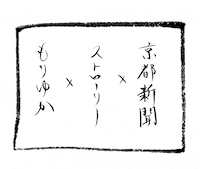 Stroly
Stroly
アンケートにご協力ください。
![]() Stroly
Stroly
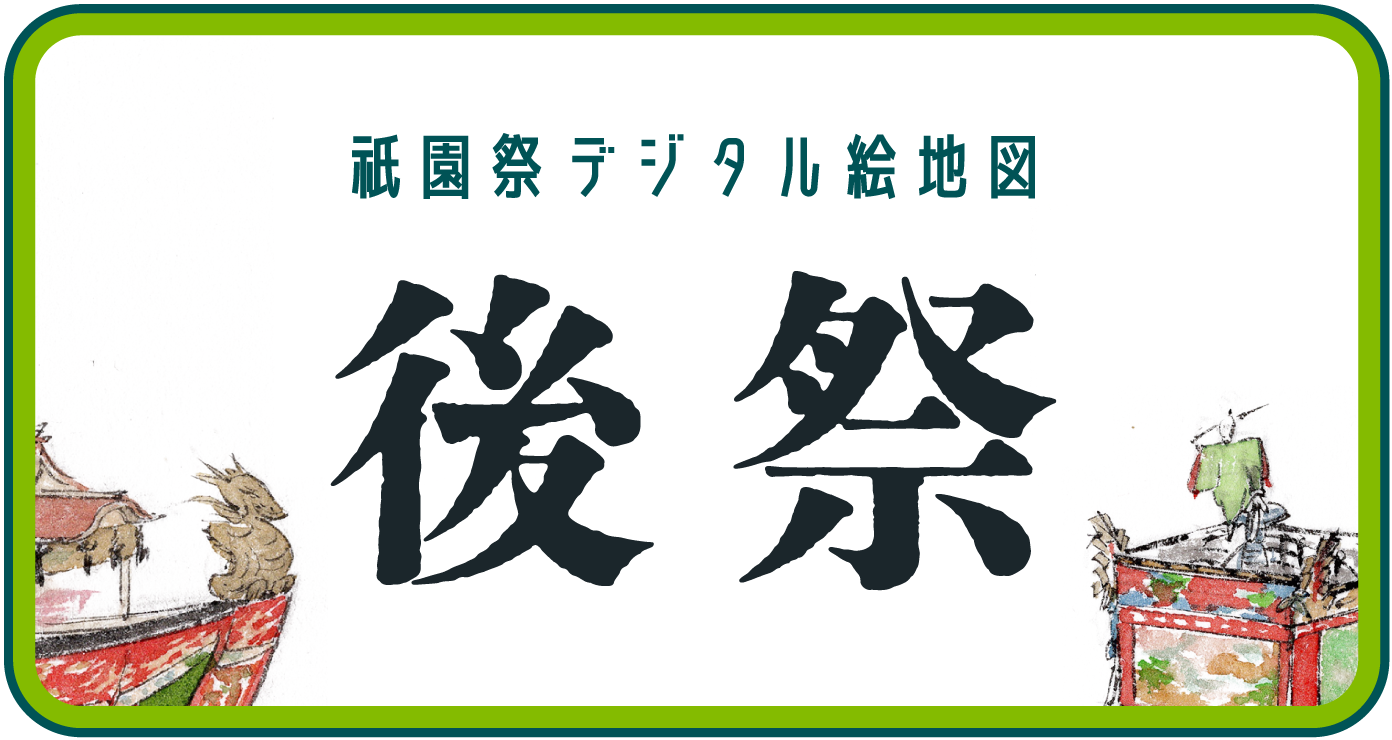
本プロジェクトについて Stroly Inc.について 祇園祭デジタル絵地図をお楽しみいただきありがとうございます。 祇園祭絵地図のご利用について、アンケートにご協力お願いいたします 現地でお楽しみの方向け 遠隔地でお楽しみの方向け 本プロジェクトについて 京都新聞社とStroly Inc.でコラボレーションを行い、昨年に引き続き「祇園祭絵地図」を公開しました。現地だけでなく、お家でも祇園祭を楽しめる仕掛けをたくさんご用意しております。 今年も、京都在住のイラストレーター、もりゆかさんによるイラストマップです。鳥獣戯画を彷彿とさせる軽やかなタッチで描かれた個性豊かなキャラクターが、祇園祭を楽しむ様子をご覧いただけます。 各山鉾ごとの由来や説明に加え、祇園祭に関連する神事や行事もご覧いただけます。ぜひ沢山の山鉾を巡って、祇園祭を余すことなくお楽しみください! ↓後祭マップはこちら↓ Stroly Inc.について Stroly(ストローリー)は、イラストマップをオンライン化するプラットフォームを運営しています。京都祇園祭開催地域の方々は、お手持ちのスマートフォンやタブレットのGPSを使って、現在地を確認しながら当コンテンツを楽しむことができます。現地に実際に行くことができない方は、マップにアクセスした際、キャラクターを選択いただくと、複数のユーザーと同時参加・会話ができます。 公式HP
 祇園祭とは
祇園祭とは

由来と歴史 スケジュール 見どころ 使い方 このマップでは、2025年7月1日(火)から7月17日(木)にかけて行われる祇園祭の山鉾巡行とGPS連動による現在地情報をご覧いただけます。 是非、お気に入りの山鉾を見つけて ブックマークしてくださいね!! 祇園祭とは 日本の三大祭の一つに挙げられる祇園祭は、毎年7月1日から31日までの1カ月間、京都市内の中心部や八坂神社(東山区)で行われる。クライマックスの山鉾巡行や神幸祭をはじめ、多彩な祭事が繰り広げられる。 長刀鉾を先頭に河原町通りを進む山鉾。 夏の日差しに生える優美な須賀らを大勢の観客が見守った。 祇園祭の由来と歴史 平安時代前期の869(貞観11)年、京で疫病が流行した際、広大な庭園だった神泉苑(中京区)に、当時の国の数にちなんで66本の鉾を立て、八坂神社の神輿を迎えて災厄が取り除かれるよう祈ったことが始まりとされる。 応仁の乱(1467~77年)で山鉾巡行は途絶えたが、1500(明応9)年に町衆の手で再興された。 以後、中国やペルシャ、ベルギーなどからもたらされたタペストリーなどを各山鉾に飾るようになった。 これらの懸装品の豪華さゆえに、山鉾は「動く美術館」とも呼ばれる。 江戸時代にも火災に見舞われたが、町衆の力によって祭りの伝統は現代まで守られている。2009年にはユネスコ無形文化遺産に登録された。 山鉾巡行は本来、神輿渡御に伴う「露払い」の位置づけで、神幸祭に先立つ「前祭(さきまつり)」と還幸祭の「後祭(あとまつり)」がある。 高度成長期以来、交通渋滞や観光促進を理由に、前祭と後祭の合同巡行が続いていたが、 祭り本来の形を取り戻そうと分離が決定。2014年、約半世紀ぶりに後祭の山鉾巡行が復活した。 注連縄切りの大役を堂々と果たす長刀鉾稚児 祇園祭のスケジュール 毎年、7月1日の「吉符入り」で幕を開け、2日には山鉾巡行の順番を決める「くじ取り式」が京都市役所で行われる。 10日頃から前祭の鉾建てが始まり、12日頃には鉾の「曳初(ひきぞ)め」がある。 14日の宵々々山、15日の宵々山、16日の宵山を経て、17日は、前祭の23の山鉾が祇園囃子(ばやし)にのって京都のメーンストリートを巡行。 前祭山鉾巡行の翌日から、後祭に向けて鉾建てが始まる。 21~23日は宵山期間で、24日は後祭の山鉾巡行。 あわせて花笠巡行も繰り広げられる。夕方には、神輿が御旅所から神社に戻る還幸祭がある。 石段下を埋め尽くすように集まった担ぎ手たちが気勢を上げて3基のみこしを運ぶ。 祇園祭の見どころ 前祭・山鉾巡行まで12日頃の「曳初(ひきぞ)め」は、女性を含む一般市民も参加できることが多い。16日の宵山までは、各山鉾町ではちょうちんの明かりに照らされた山や鉾が楽しめる。各山鉾では、病気除けとされるちまきや、学問成就や立身出世などのお守り(護符)を手に入れることもできる。 前祭・山鉾巡行当日午前9時、計23基の山鉾が四条烏丸付近を出発。四条通を東へ向かった後、河原町通を北上し、御池通を西進する。四条麩屋町での長刀鉾稚児による「注連縄(しめなわ)切り」や、山鉾が各交差点で方向を変える「辻(つじ)回し」などが見どころ。 後祭・山鉾巡行まで前祭の山鉾巡行の翌日から、大船鉾の鉾建てが始まる。宵山では露店の出店が規制され、本来の祭り情緒が楽しめそう。 後祭・山鉾巡行当日午前9時半に計11基が烏丸御池を出発。前祭とは逆向きのコースを進む。復活した大船鉾や、前祭とは逆向きの辻回しなどに注目が集まる。 後祭列が復活するまで長らく代わりとなっていた花傘巡行の行列も、後祭列を追うよう御池通や河原町通を進む。 車輪をきしませながら「辻回し」を披露する長刀鉾 GPS機能について GPSをオンにします。オンの状態では、ボタンが青色に変わります。再びクリックすると、GPSがオフになります。 Q&A Q. 位置情報(GPS)の取得に失敗します。 ①位置情報の利用が許可されていない場合 「位置情報の利用が許可されていません」と表示される場合は、端末やブラウザで位置情報(GPS)の取得が許可されていません。端末側の設定をご確認ください。 ②現在位置の取得に失敗する場合/現在位置が時間以内に取得できない場合 屋内ではGPS信号の受信ができないことがあります。場所を変えてもう一度お試しください。 詳しくはこちら (c) The Kyoto Shimbun Co.,Ltd. All rights reserved.
